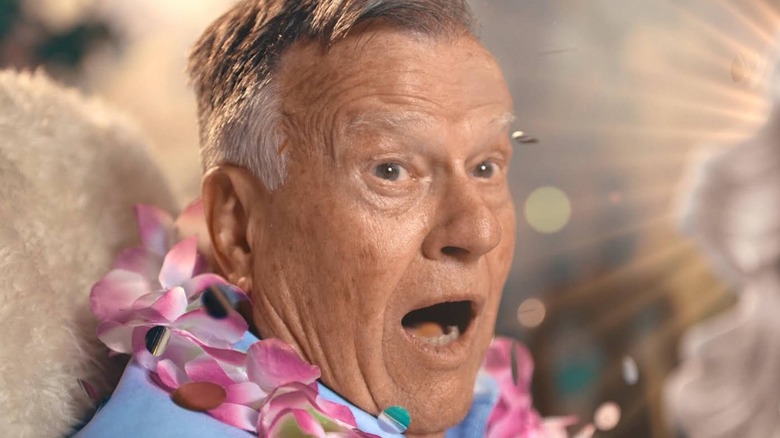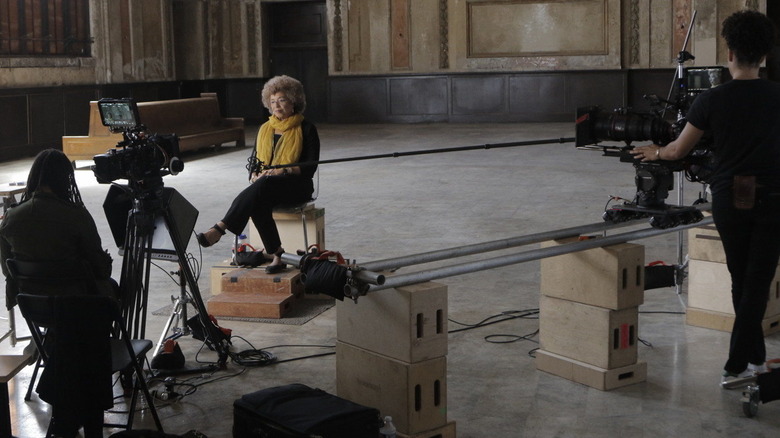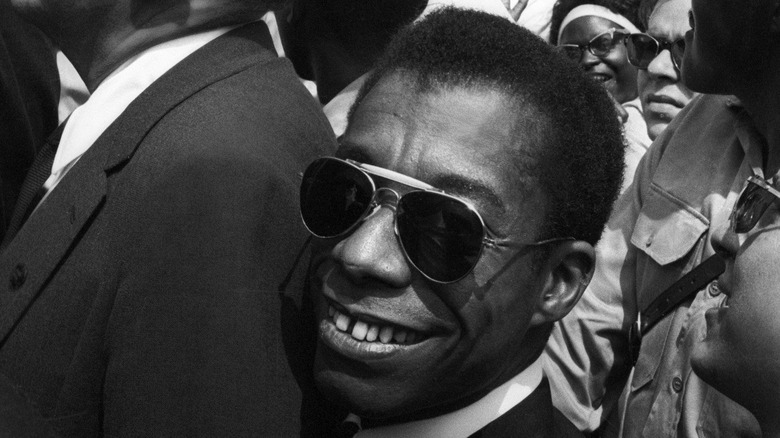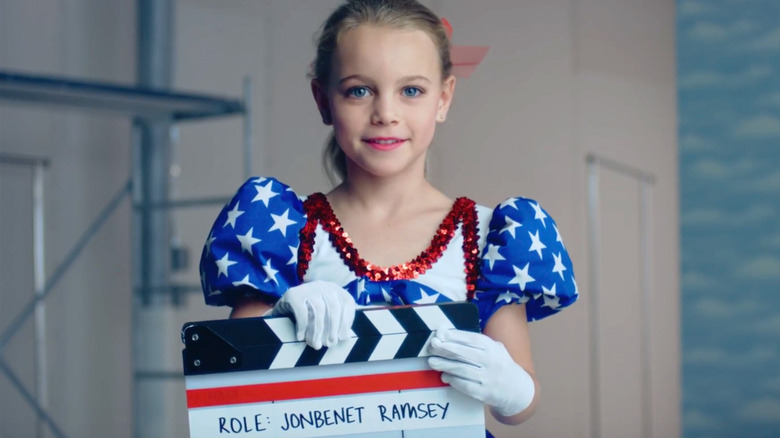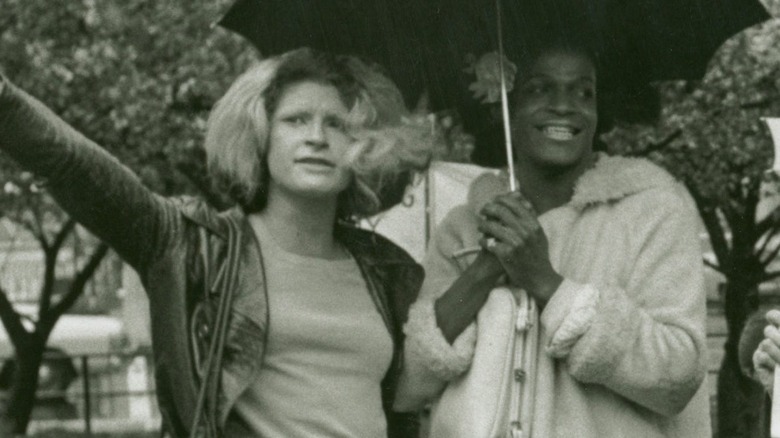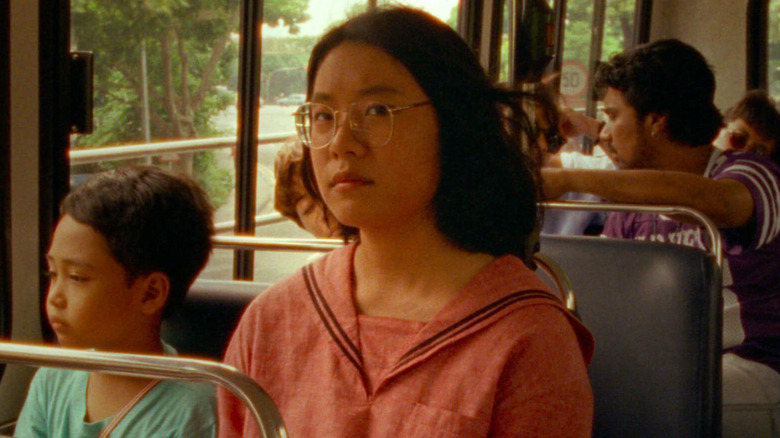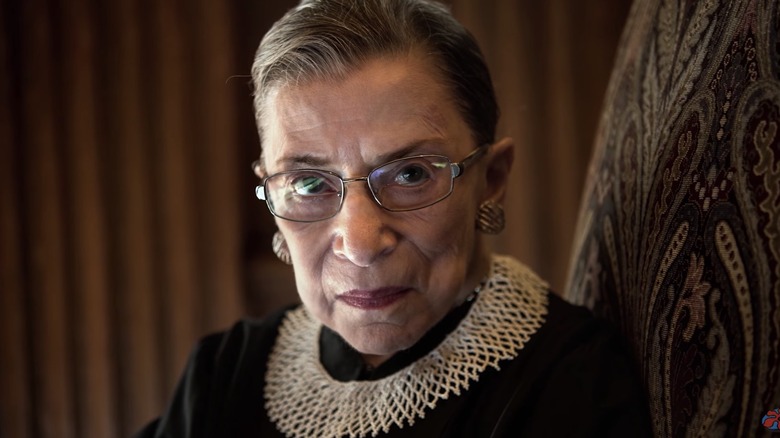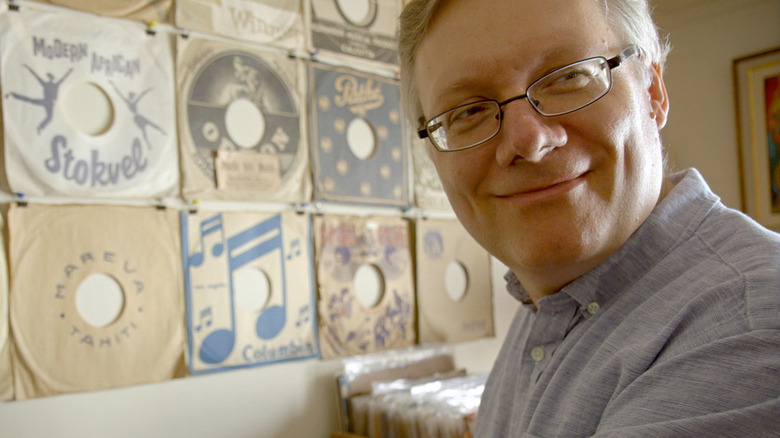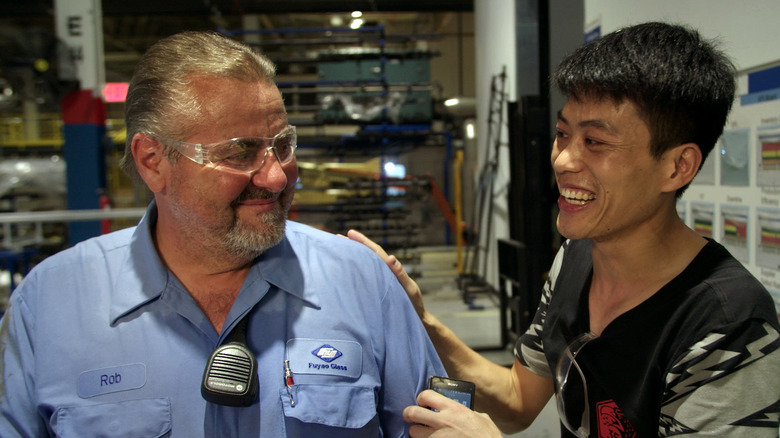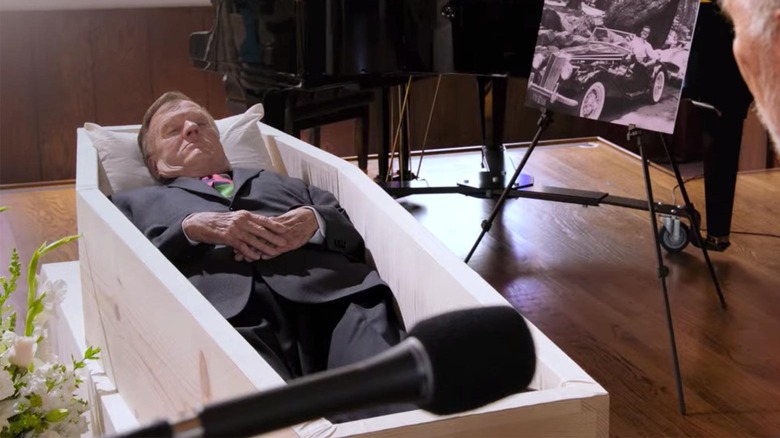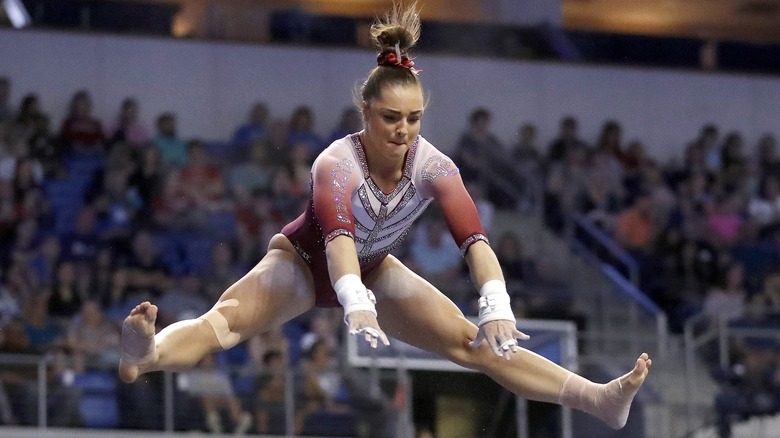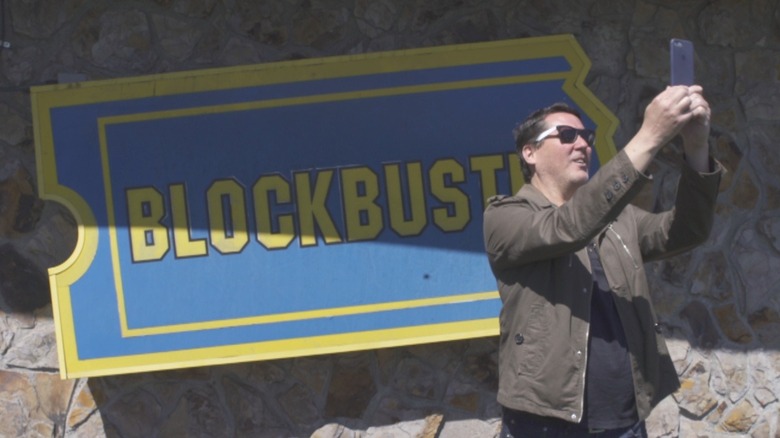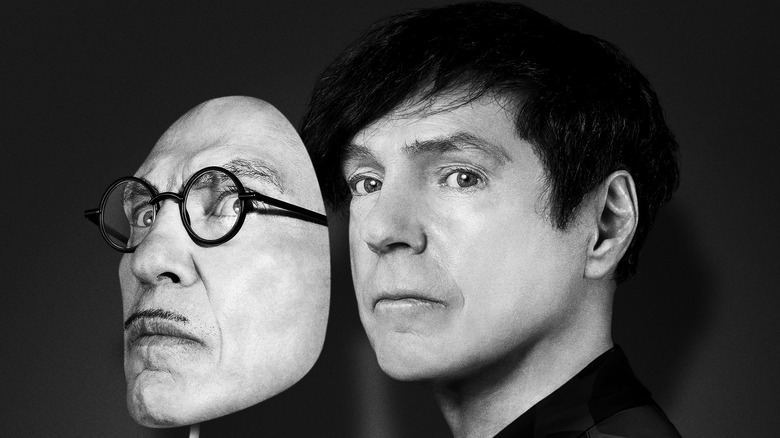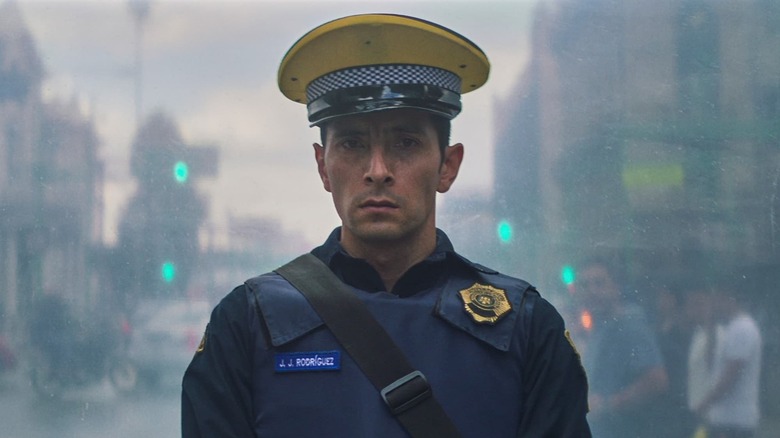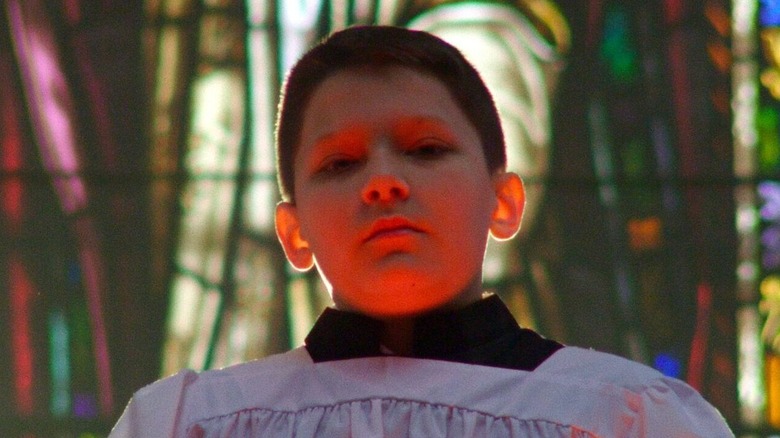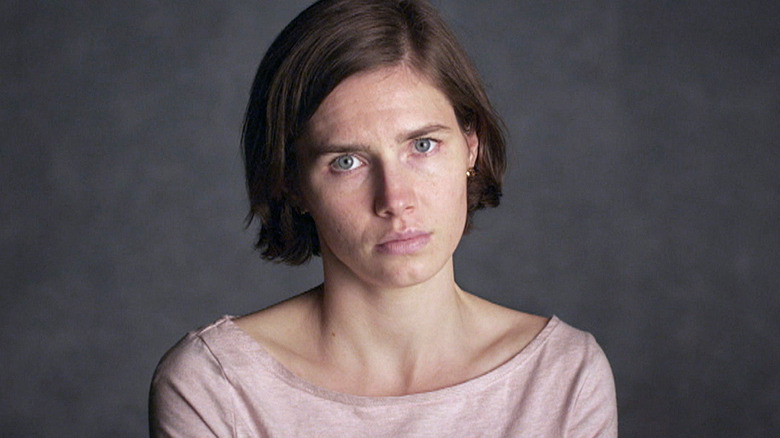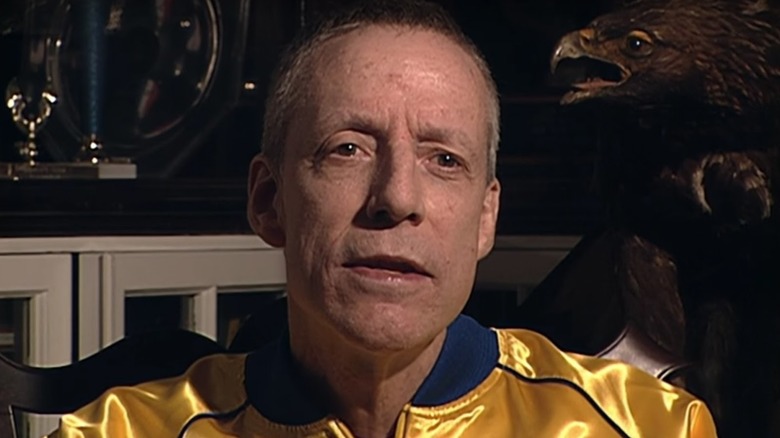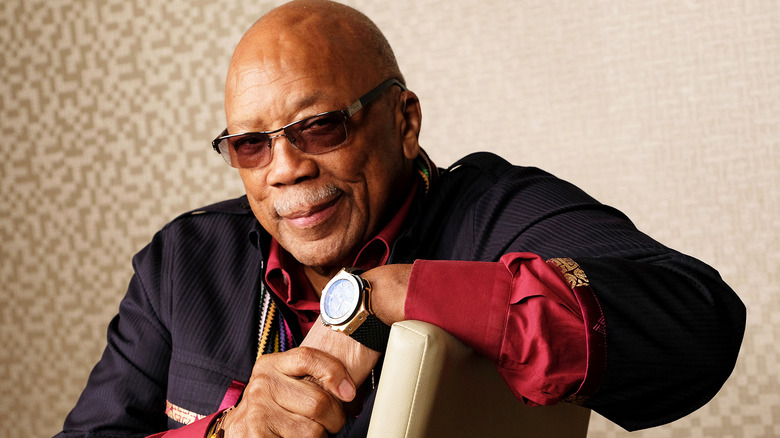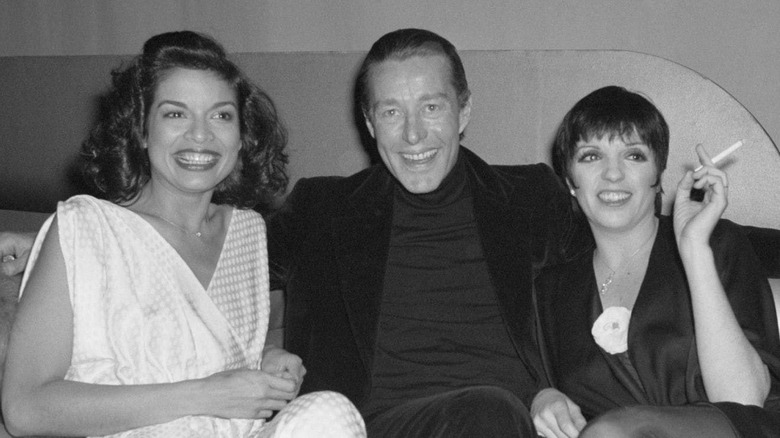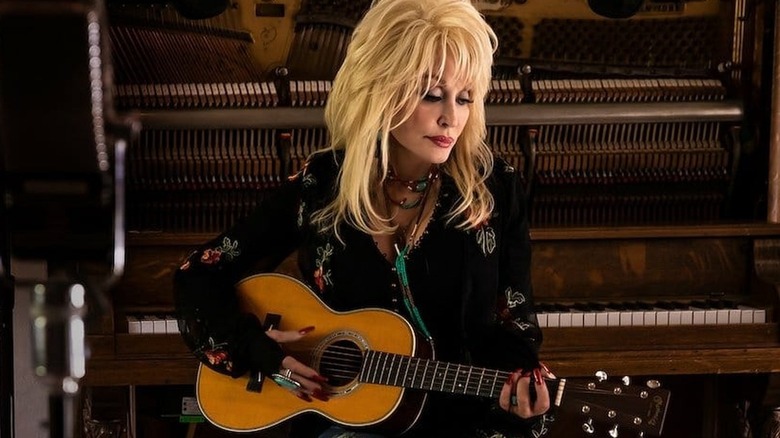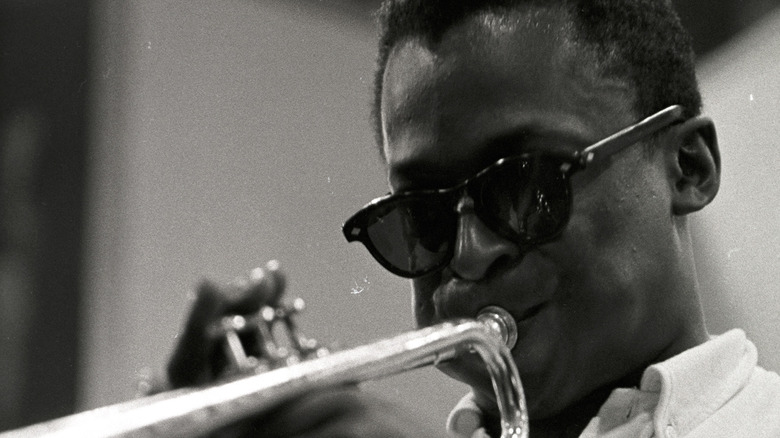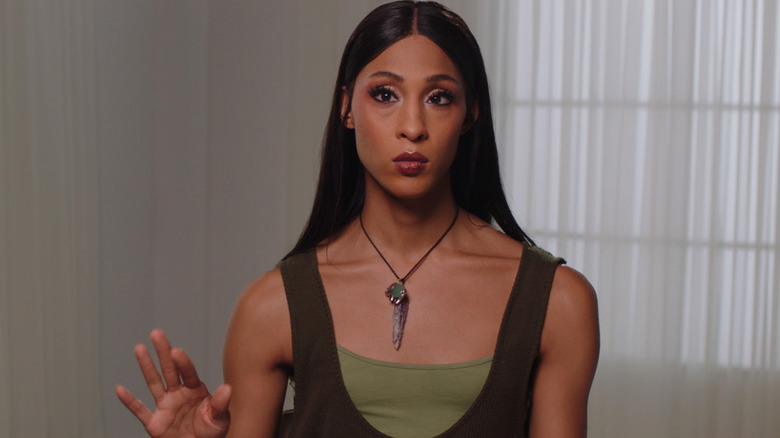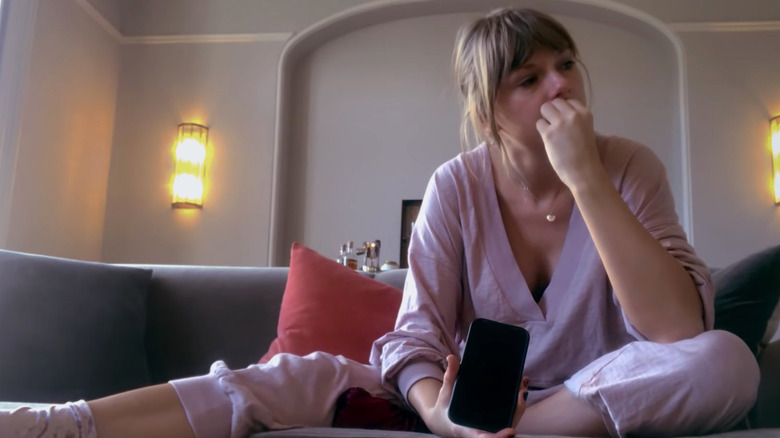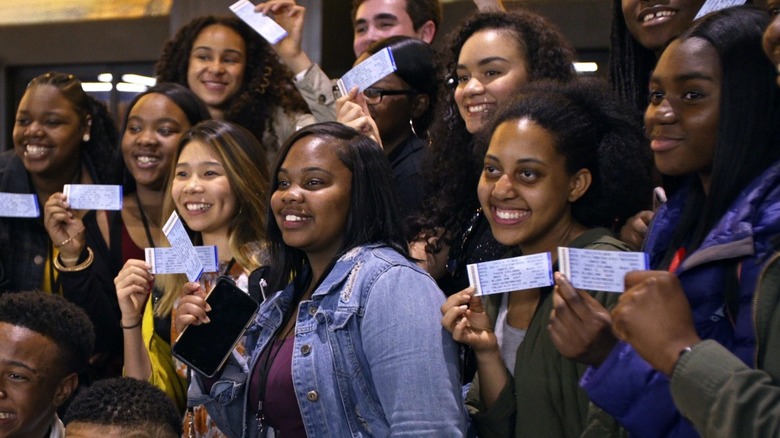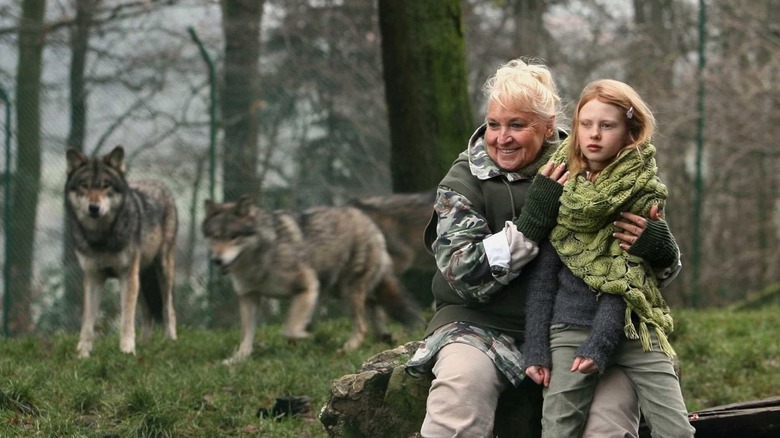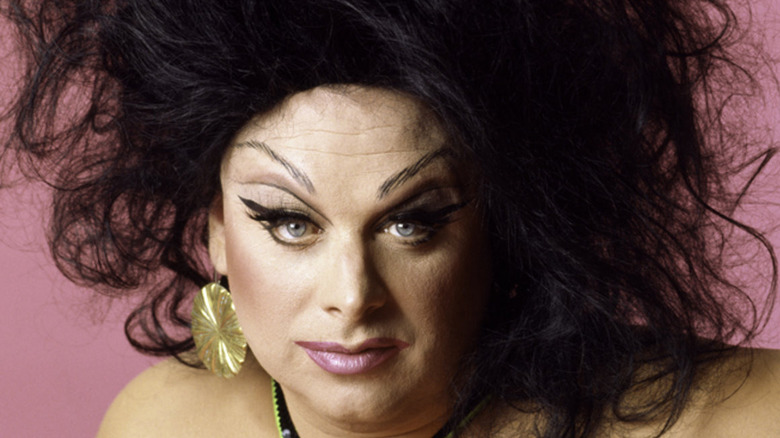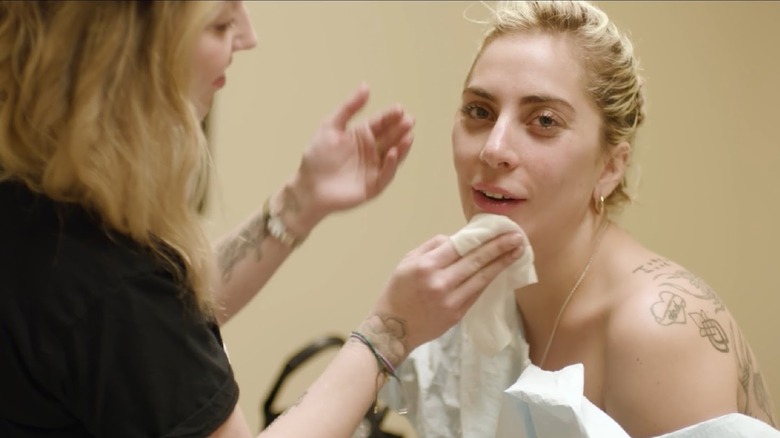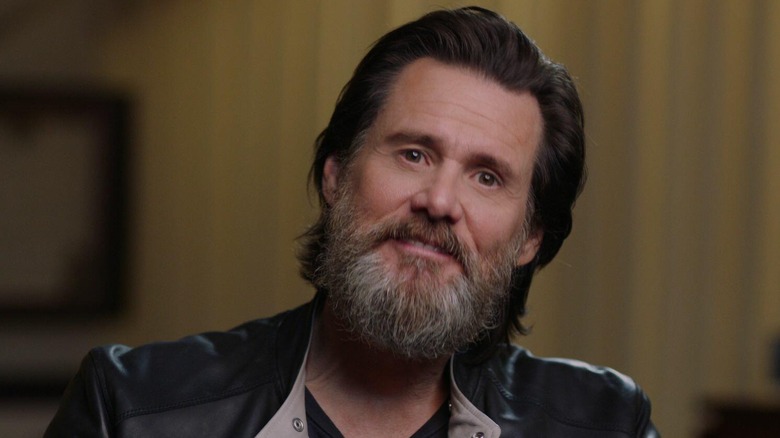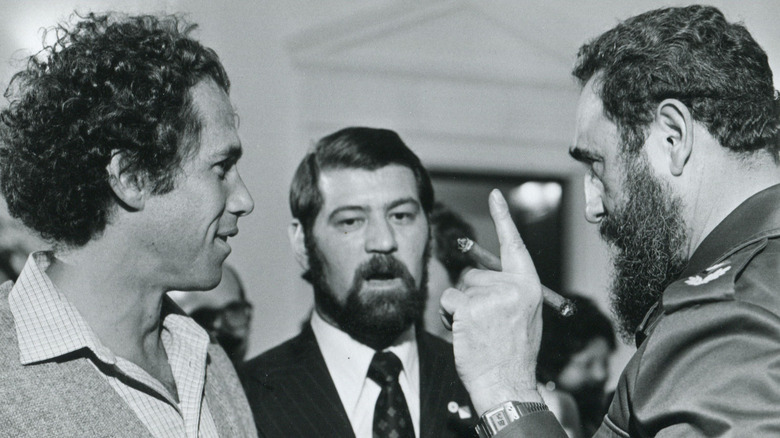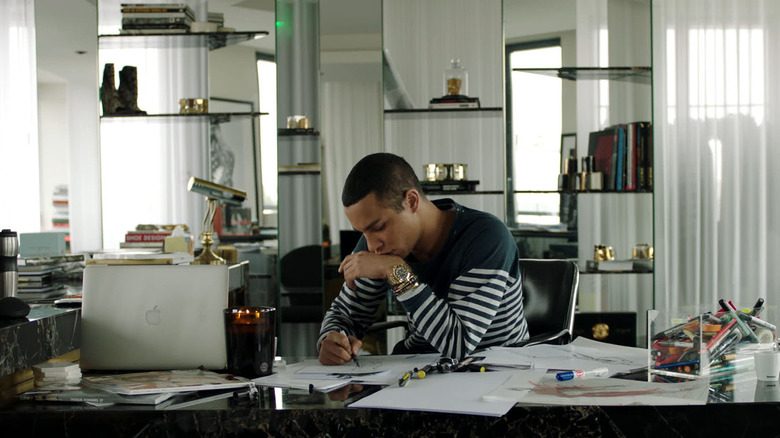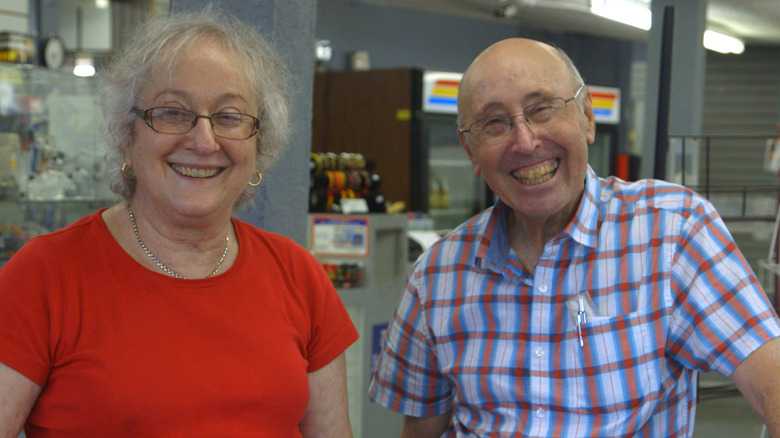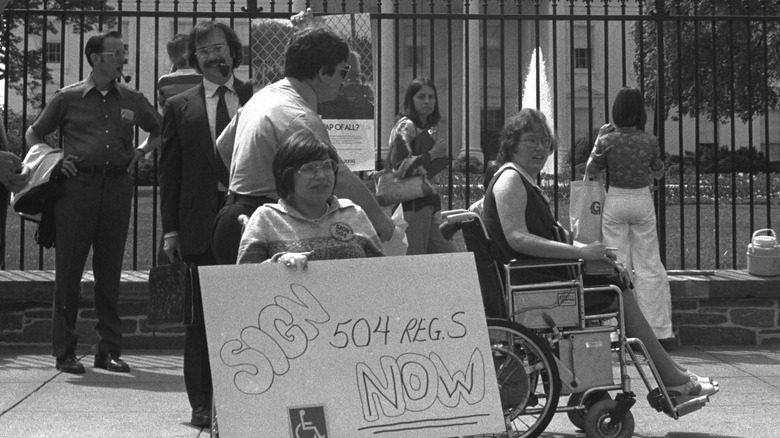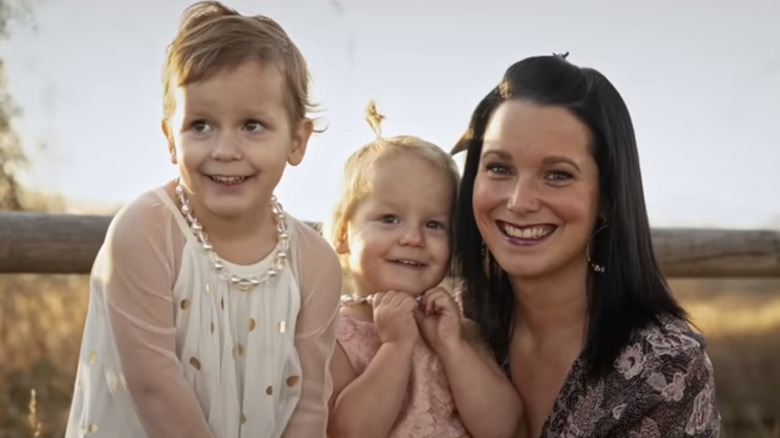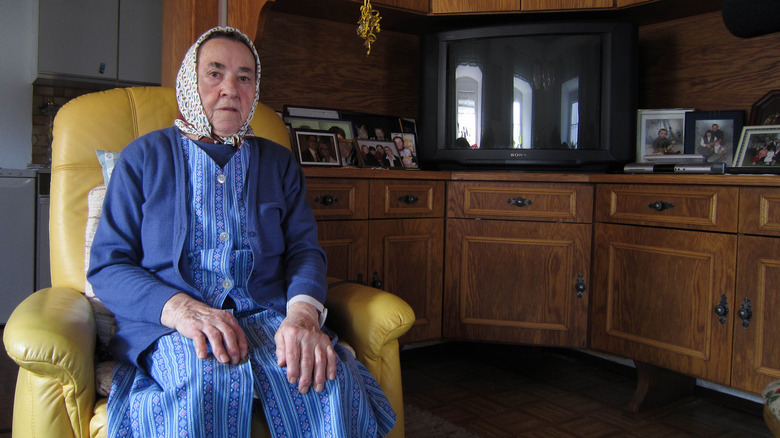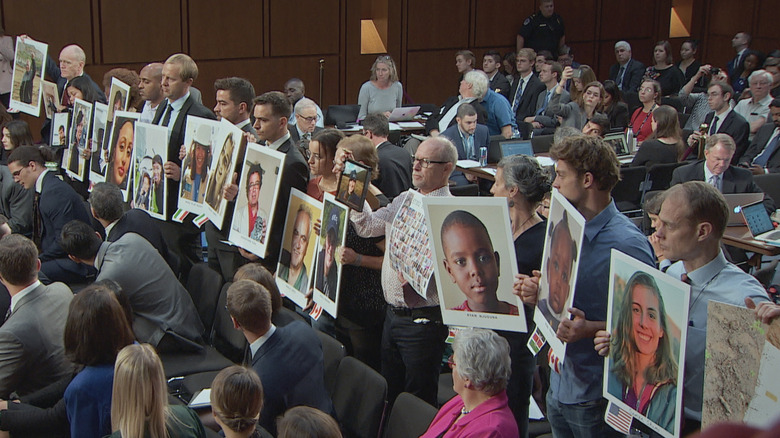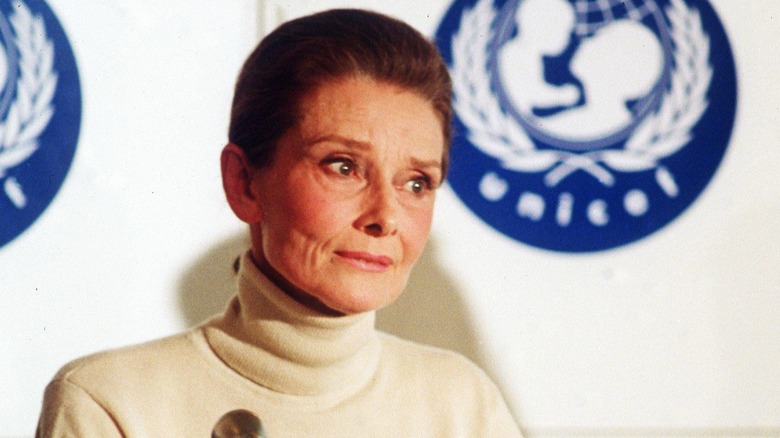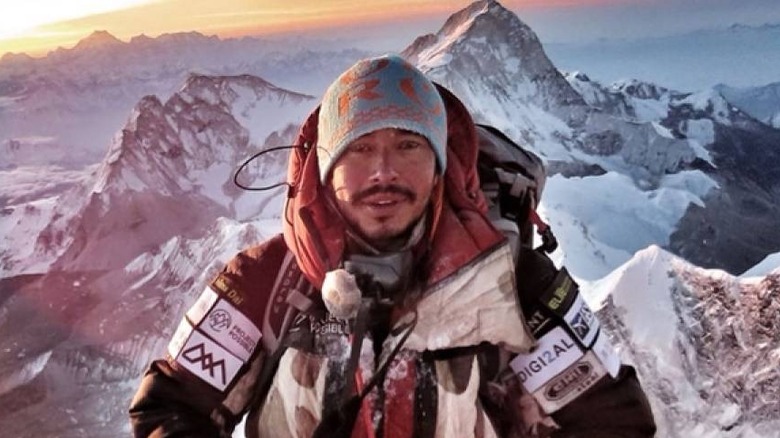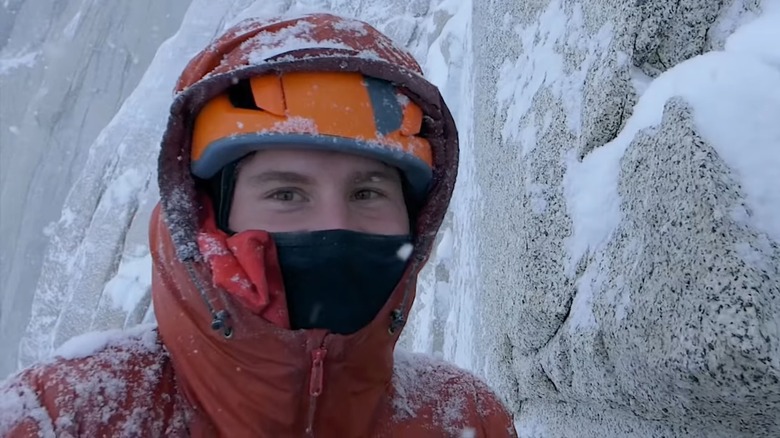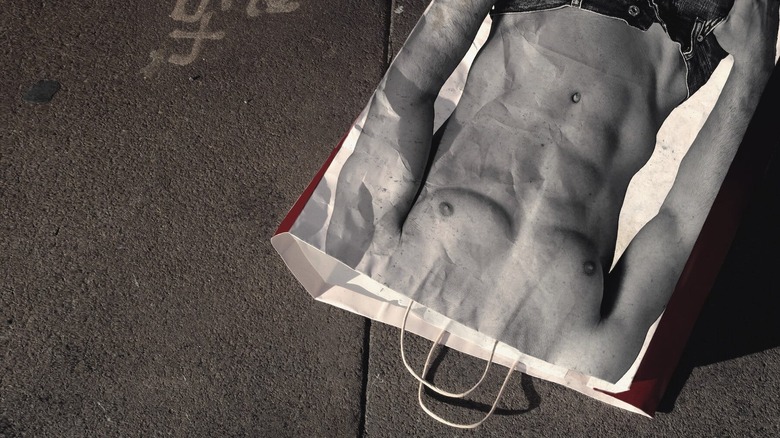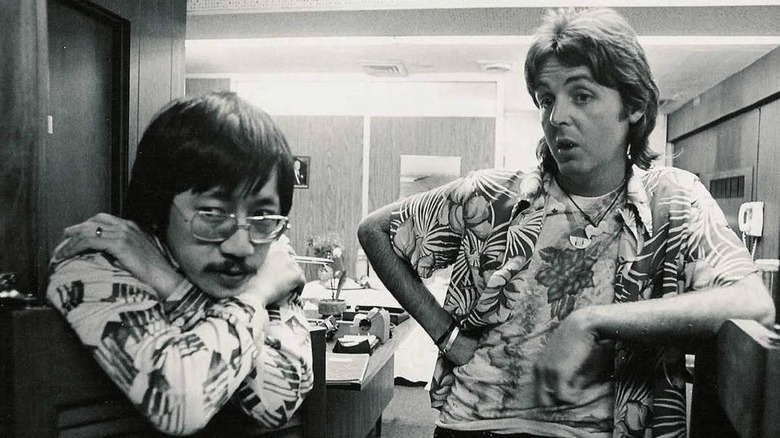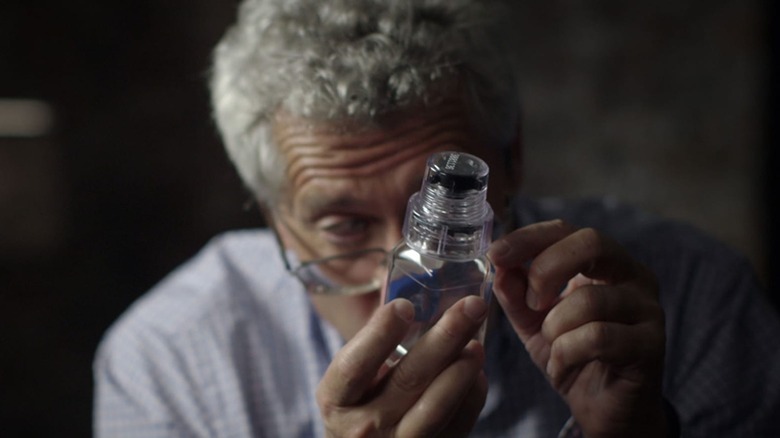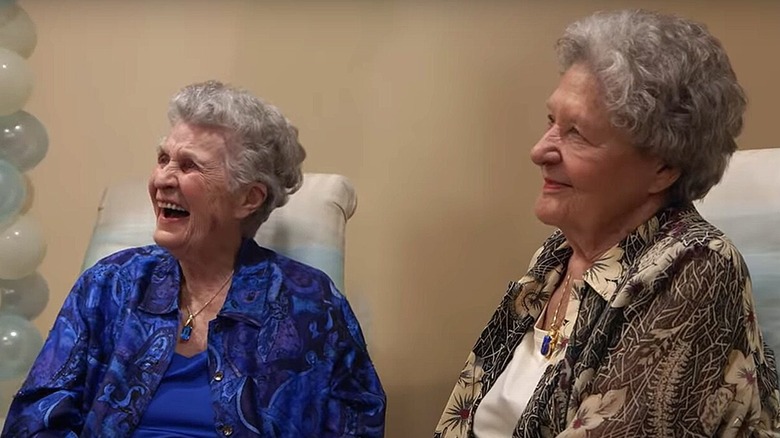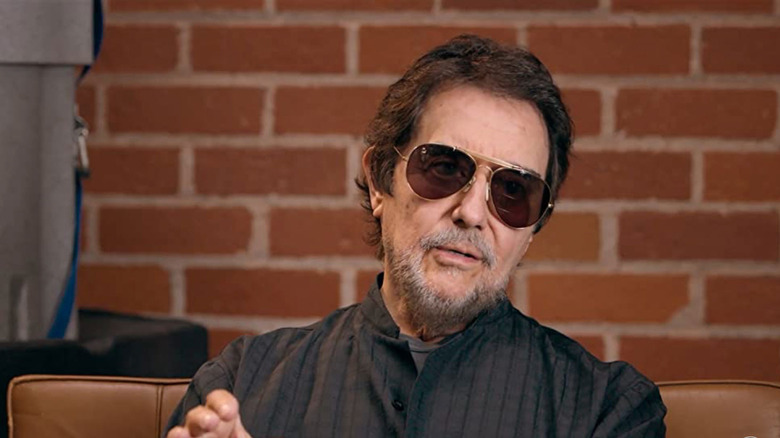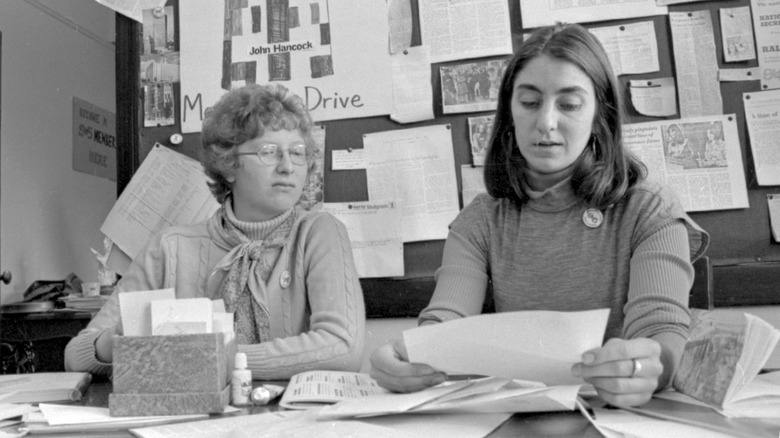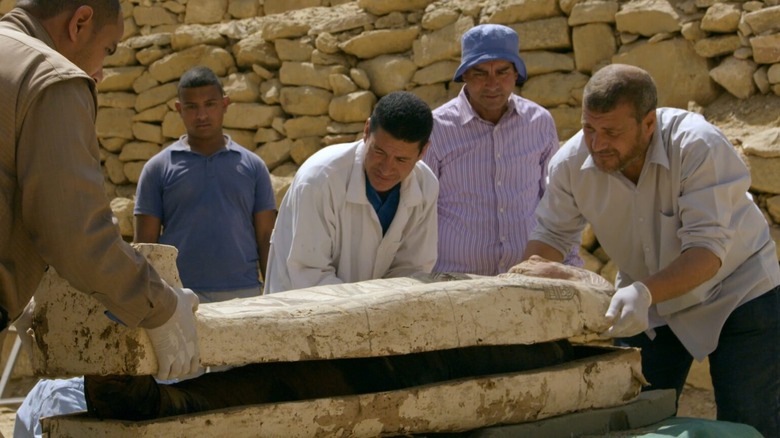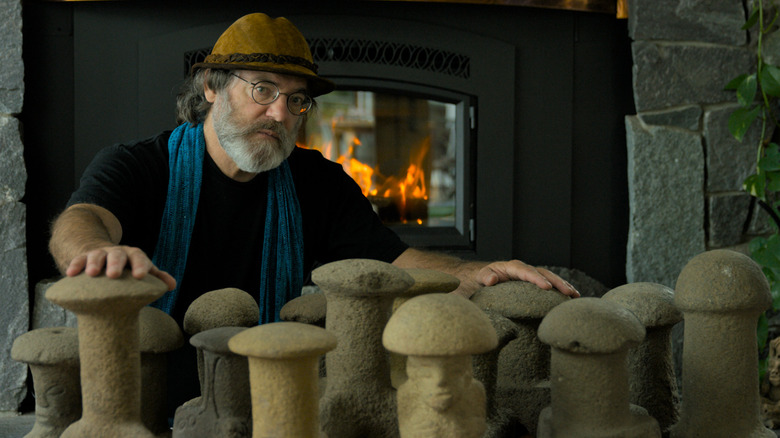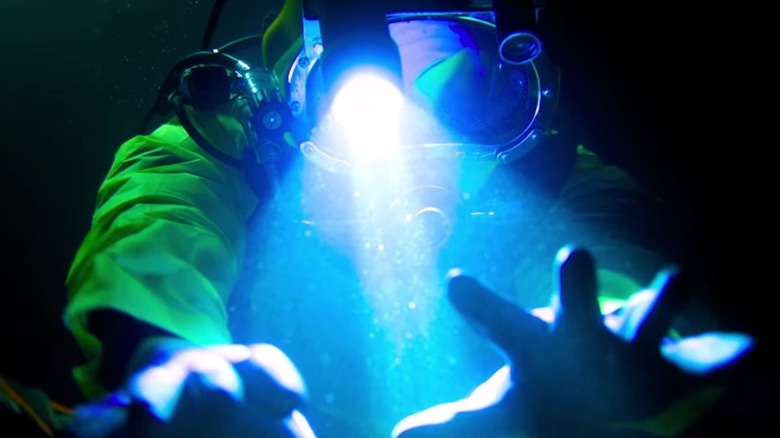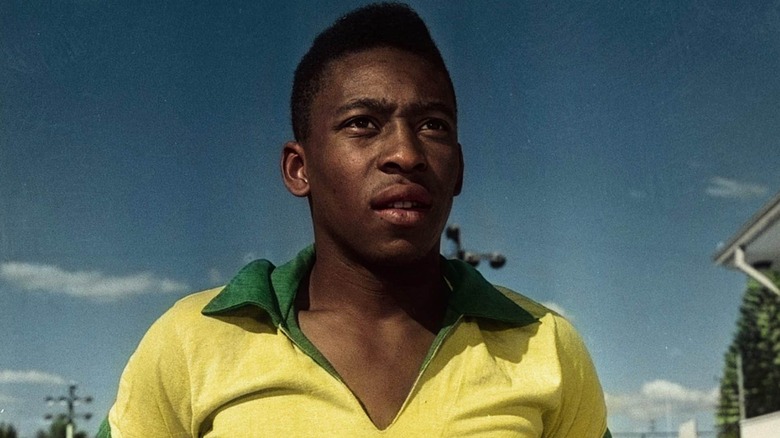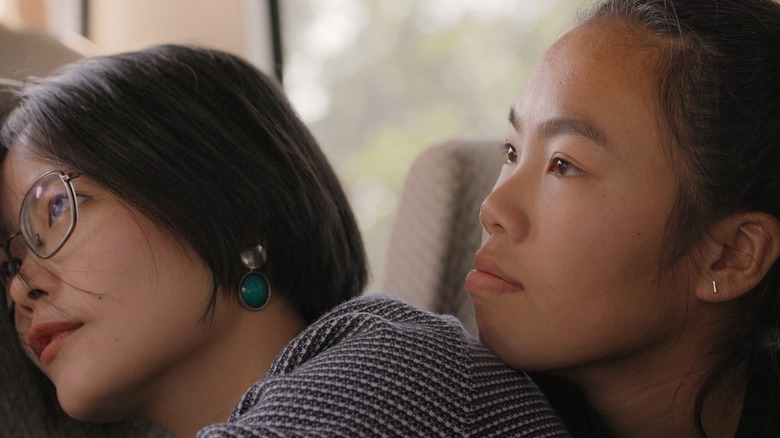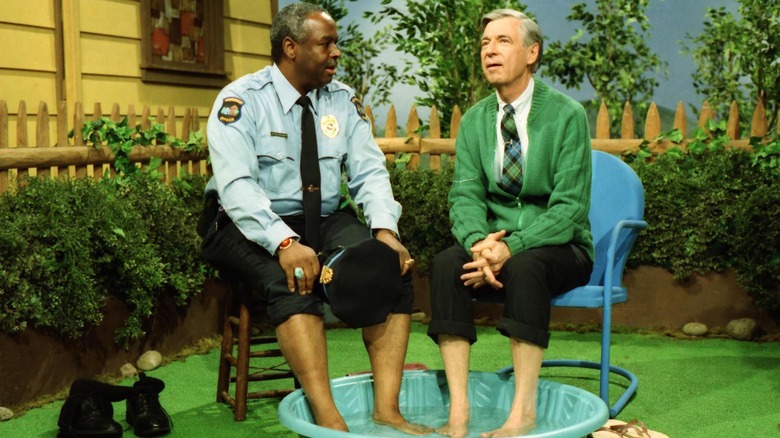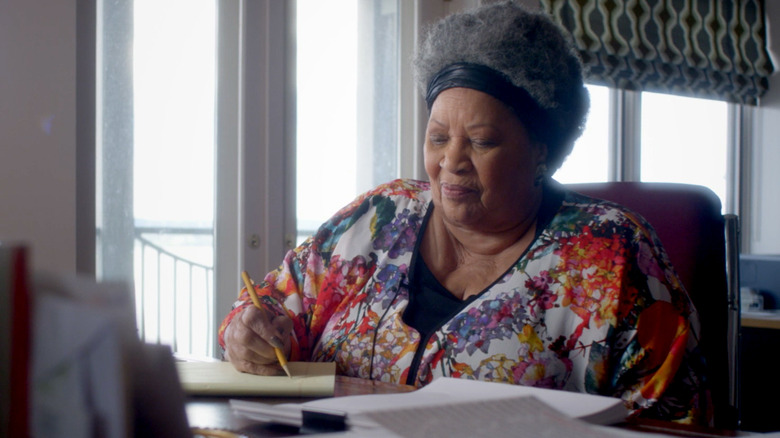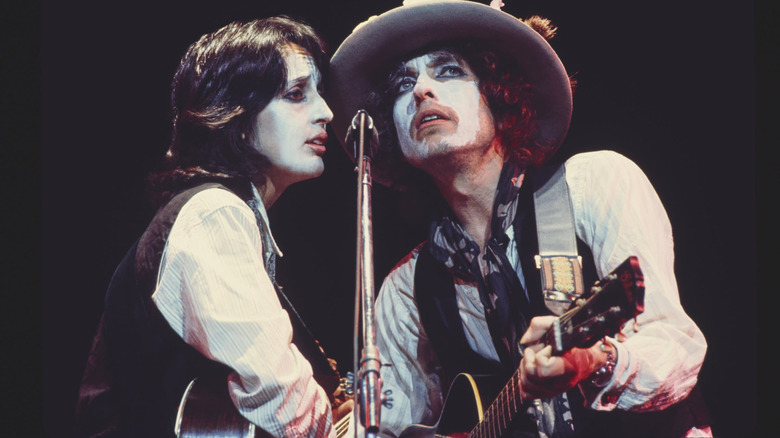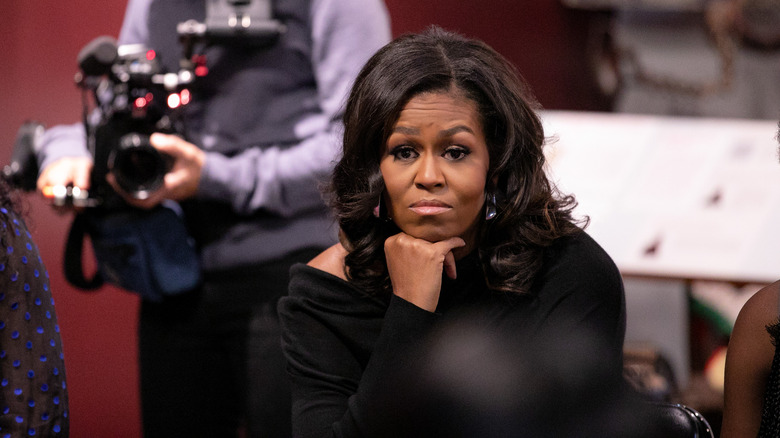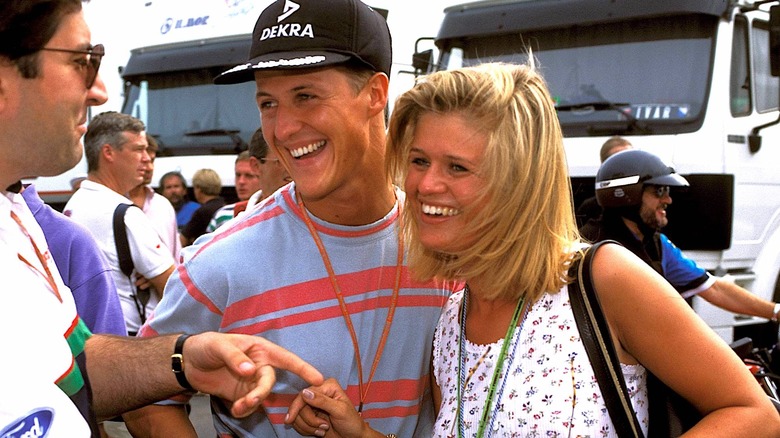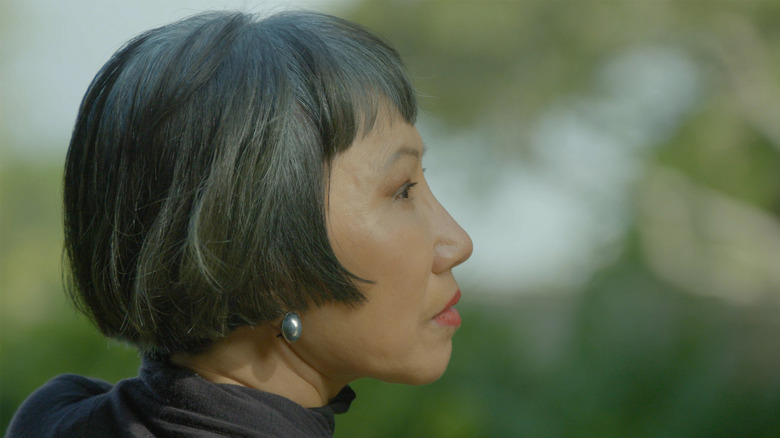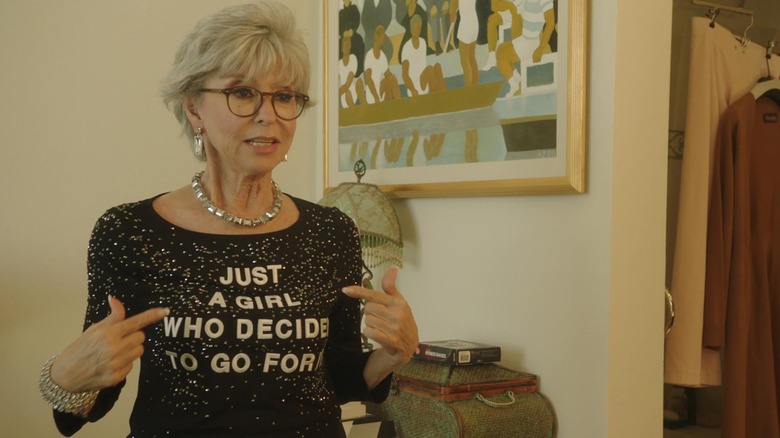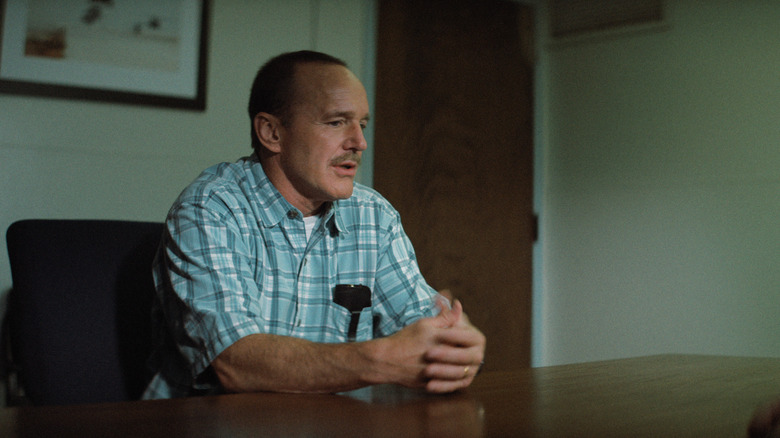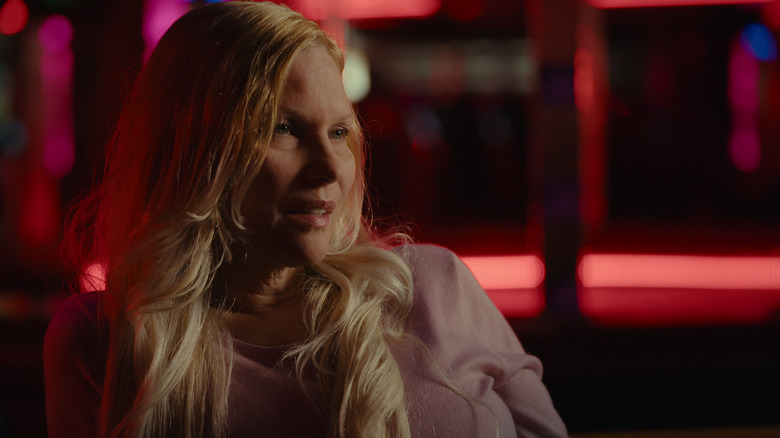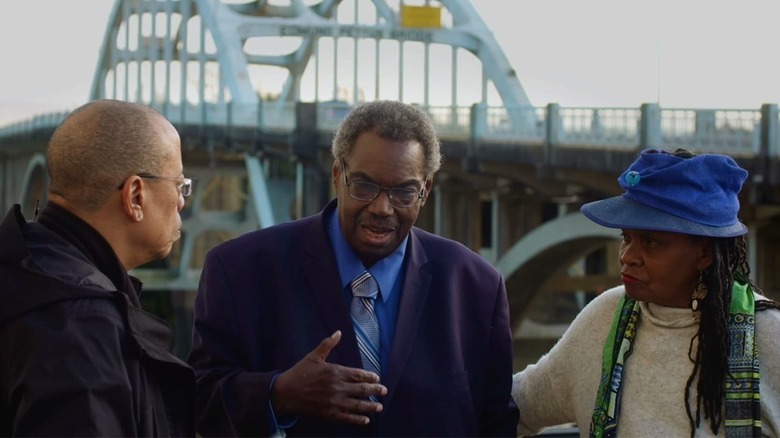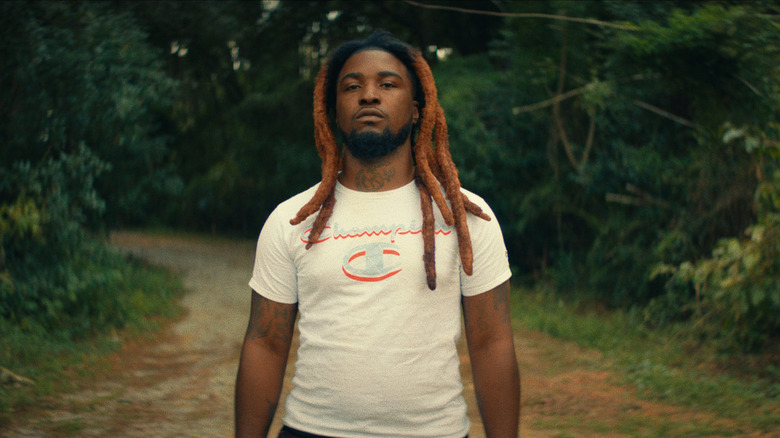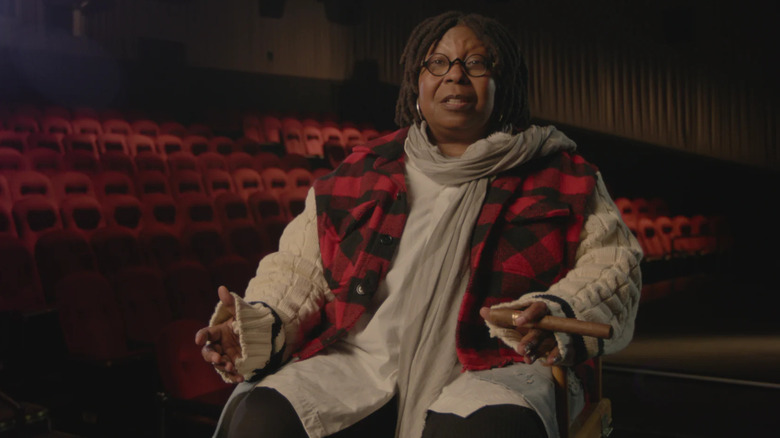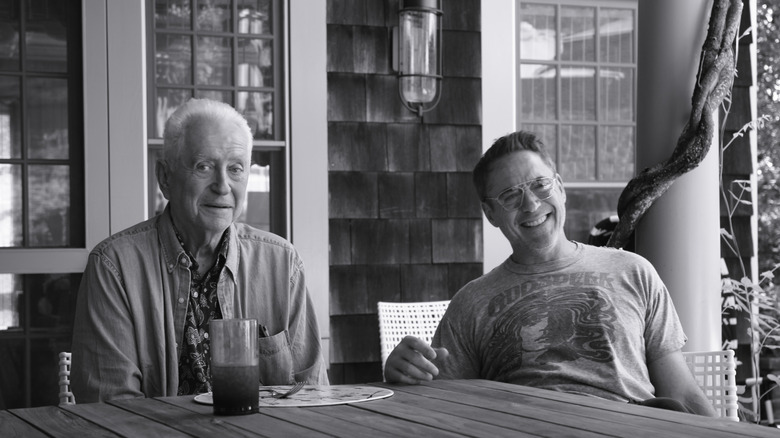The 65 Best Documentaries You Can Watch On Netflix Right Now (January 2023)
While Netflix is starting to make inroads into the best picture category at the Oscars, it's been making a strong showing in the best documentary competition for some time. Although its feature documentary catalog does not stretch very far into the past and is mostly American, it still has plenty of docs that are worth discovering.
True crime stories, like the murder of JonBenet Ramsey and the sexual abuse of U.S. gymnasts, are popular topics, but there are also documentaries on prominent figures from recent history, such as James Baldwin, RBG, and Beyoncé. There are explorations of social issues, including racism and the corruption of corporations under capitalism. Even if the subject is something that the viewer feels they know well, watching these documentaries should still be an act of discovery, providing new information on a well-worn topic, trying to solve a mystery, or shedding light onto a hidden scandal.
Four films on this list are hybrid documentaries that blur fiction and non-fiction, using reenactments to explore their subjects and turning drama into a form of therapy, while perhaps the most rewarding defies definition entirely. Here are the 65 best documentaries that you can watch on Netflix right now.
13th
Ava DuVernay's brilliant essay-on-film draws a direct line from the days of slavery and the 13th amendment to the modern prison-industrial complex, which is essentially slavery under another name. With contributions from Angela Davis, Van Jones, Cory Booker, and even Newt Gingrich, this is a wide-ranging discussion of how the history of the United States has directly led to the over-incarceration of Black men, who can be used as for-profit labor by the corporations that run private prisons.
Policies such as segregation and voter suppression all contribute to this phenomenon, as do Republican politicians, who regularly overstate how much crime cities face in order to appeal to their voters. In fact, as "13th" shows, violent crime rates are actually dropping, but the number of people being incarcerated is higher than ever.
DuVernay provides forcefully persuasive evidence, and you will likely come away from "13th" feeling fired up and angry. The use of music really adds to this propulsive, very well-edited documentary. It's an overwhelming experience, but feels like it should be mandatory viewing.
I Am Not Your Negro
An adaptation of James Baldwin's unfinished work "Remember This House," this extraordinary documentary by Raoul Peck is divided into chapters and chronicles Baldwin's complicated relationship with America, as well as his memories of Medgar Evers, Malcolm X, and Martin Luther King Jr.
In addition to footage of television interviews with Baldwin, the writer's words are compellingly narrated by Samuel L. Jackson. "I Am Not Your Negro" examines portrayals of Black people in the media, including in films and advertising, during the 20th century. The Kennedys, particularly Bobby, are prominent figures in the story, which includes a recount of a meeting between Lorraine Hansberry, Baldwin, and Kennedy.
Rather than attempting to be an all-encompassing documentary about Baldwin, Peck wisely does two things: he uses Baldwin's own words to communicate his message, and also keeps the focus fairly narrow. We don't find out much about Baldwin's time in France or his writings on sexuality, for example. Baldwin's urgent, insistent words are about America as a country and the reckoning it must have with itself in order to change for the better.
Casting JonBenét
Before making our skin crawl with the narrative feature "The Assistant," director Kitty Green used the still-unsolved murder of six-year-old JonBenét Ramsey as a jumping-off point for a fascinating hybrid documentary. Green uses the casting of the main figures involved in the case for the purposes of filmed reconstructions to discuss how Ramsey's murder became a media sensation, and how it led to many different theories as to who killed her and for what reason.
The main thing that attracted so much attention to the case was that JonBenet had been entered in beauty pageants by her mother, Patsy. Like the Ramseys, many of the women and men auditioning to play Patsy and her husband, John, are from Boulder, and during the documentary share personal anecdotes related to the crime, as well as lots of speculation about the parents' involvement.
Seeing how the different actors calibrate their performances based on their opinions of the people involved in the case is one of the most interesting aspects of the film. "Casting JonBenet" is an unusual twist on the true crime genre, one that is more about people's interpretations of the events in question than the murder itself. It is not the only documentary on this list that uses acting as a way to discuss or cope with real traumatic events; still, it's a revelatory way of exploring difficult subjects.
The Death and Life of Marsha P. Johnson
This documentary follows Victoria Cruz's investigation into the 1992 death of Marsha P. Johnson, an activist for LGBTQ rights and a prominent figure in the Stonewall riots. Despite its title, the documentary gives almost equal attention to Johnson's close friend and fellow activist Sylvia Rivera, who died 10 years after Johnson. There is a lot of footage of Rivera available, most of it heartbreaking, including her being booed while trying to speak at a Gay Pride event, and footage from when she was homeless, living at the same Hudson River piers where Johnson's body was found.
Cruz diligently and tirelessly tracks down people who can tell her more about Johnson's life and death, including her friend Randy, who Johnson lived with for over a decade. Many different theories are posited as to what may have caused Johnson's death, which was officially ruled a suicide. Perhaps she fell in the river while being pursued by homophobic attackers, or maybe she was the victim of a Mafia hit.
Unfortunately, answers probably won't be found, but Johnson and Rivera's lives and the lessons they can teach us still matter — as the documentary shows, the same issues that Johnson and Rivera were fighting in the 1970s are still relevant in the 2010s. "The Death and Life of Marsha P. Johnson" is an important watch.
Shirkers
If I could urge you to watch a single documentary on this list, it'd be this one. "Shirkers" is the story of a group of young filmmakers who made a film in Singapore in 1992, only to have the footage stolen by an older man who was supposed to be their mentor.
As someone of a similar age to director Sandi Tan, "Shirkers" is incredibly relatable to me. In the '90s, Tan wanted to be a Coen sister, had a shrine to Brecht, and made collages and homemade zines. Watching "Shirkers" makes me desperately want to be friends with Sandi, Jasmine and Sophie both as teenagers, and also as adults. As someone who has remained friends with the same group of people for decades, their relationships are extremely recognizable to me, particularly Jasmine constantly calling Sandi out as an a-hole.
"Shirkers" is one of the most energizing, invigorating, and inspiring documentaries ever made. It's frustrating to see footage of what looks like an amazing film that was lost and never properly finished. However, the documentary also shows us what's possible when a group of friends comes together and invests in a project for a summer. It's a snapshot of a time and place, even as it somehow evolves into a detective story. It's simply an all-time great documentary.
RBG
Julie Cohen and Betsy West released two documentaries in 2021, "My Name is Pauli Murray" and "Julia," but they are still best known for their 2018 film "RBG." Released a couple of years before Ginsburg's death, this film manages to almost deify the subject by looking at how the long-standing Associate Justice of the Supreme Court became a pop culture icon.
There is so much to Ginsburg's life that, even with a feature-length running time, a documentary or a biopic (see, for example, "On the Basis of Sex") is always going to feel like skimming the surface. In addition, it's always odd when one of the talking heads in this style of documentary is the subject herself. However, despite being made in a straight-forward way, "RGB" offers enough information on Ginsburg's fascinating life to make it worth watching, especially if it's your introduction to her story.
It's still astounding to discover how little women were allowed to do just a few short decades ago, and how limited their options were. Through seeing the incremental changes that RBG managed to pass into law, we get a good understanding of how women's rights evolved over the course of the 20th century. The memes may be annoying, but Ginsburg is such a monumental figure that she probably deserves an entire documentary series, to say nothing of an individual feature.
Bathtubs Over Broadway
Not every documentary has to be about a hard-hitting subject in order to be compelling. Sometimes, a topic with low stakes can be a welcome change of pace. In fact, some of the best documentaries are about extremely niche interests, and films like those only work if they have an infectiously enthusiastic person (or people) serving as our gateway into a weird and wonderful world.
In "Bathtubs Over Broadway," this person is the former head writer for "Late Show with David Letterman," Steve Young. At one point, Young was tasked with finding unusual vinyl records for the show, and accidentally stumbled into the hidden world of the "industrial musical." Basically, when big corporations like Ford, Hoover, or Kraft had their annual conventions, they would often commission original musicals that promoted their brand's values, offered advice to salesmen, and featured storylines involving the company's products. Young becomes obsessive about finding recordings of these musicals, as well as tracking down their writers and performers.
It's a window into the post-war consumerist boom that lasted from the 1950s through the 1980s. If you're interested in mid-20th century Americana, as I am, you will love this documentary. "If the musical is the American art form, then the industrial musical is the hyper-American art form." It illuminates an American corporate world that no longer exists, when workers served for life, and would make a great double-bill with "American Factory."
American Factory
This Oscar-winning documentary was helped by having the weight of Netflix and the Obamas behind it, but it's still a surprisingly frank look at a Chinese corporation that opens a factory in Ohio and the culture clash that ensues. Those involved presumably thought that this would be a heart-warming tale about one culture learning from another and discovering that we're not so different after all, but it evolves into something quite different in its final third.
"American Factory" ends up covering the union-busting efforts of the Chinese company and American higher-ups after the workers start to raise valid safety concerns. Filmmakers Steven Bognar and Julia Reichert may have ended up with something different than what they set out to capture, but that can often lead to the most exciting documentaries to watch unfold. One of the most eye-opening sections comes when a small cohort of American workers visits China, and it becomes clear just how different the work culture is in the two countries.
"American Factory" doesn't have one or two "main characters," and it suffers as a result, but it's a big topic with many sides to cover. The circumstances that led to the situation — the workers were initially laid off by General Motors — could fill an entire documentary themselves. "American Factory" does an excellent job at capturing a very specific moment in time in the heart of America.
Homecoming
Part concert film and part behind-the-scenes documentary, Beyoncé maintained strict creative control over "Homecoming," as she now has the power to do with all of her projects. This doesn't mean that we don't see a more vulnerable side to the superstar, however, as "Homecoming" shows her working extremely hard — shortly after giving birth to twins, no less — to get ready to headline Coachella, making her the first Black woman to do so.
The editing of the concert footage, which was filmed across two nights (one with a pink theme and one with a yellow theme, both inspired by Historically Black Colleges and Universities), is already the stuff of legend. The bleachers behind Bey are filled with a drum line, a marching band, a string section, and dancers in coordinated outfits, making for an amazing spectacle. Beyoncé is also, of course, joined by special guests such as Kelly Rowland and Michelle Williams of Destiny's Child, making it feel extra special.
If "Homecoming" were just the concert footage, it would still be spectacular, but the behind-the-scenes insights really add to the whole experience. In the end, "Homecoming" is one of the best-ever concert documentaries.
Dick Johnson is Dead
In 2016, cinematographer Kirsten Johnson made the documentary "Cameraperson," and in 2020 she followed it up with "Dick Johnson Is Dead," another highly personal work that chronicles the last stages of her father's life. "He's a psychiatrist, I'm a cameraperson. I suggested we make a movie about him dying. He said yes," Johnson explains. Johnson films her father's "death" in various outlandish scenarios (many involving stuntmen), as well as his funeral and scenes of him in heaven.
Dick Johnson is starting to suffer from dementia and, in between the silliness, there are moving scenes in which he realizes that he can no longer drive a car or live alone. However, by staging his funeral with his real friends and family, Dick Johnson gets to hear all of the nice things people say about him before he departs. This is a great film about filmmaking, and one continues the theme of acting as therapy, which is prevalent in many of the documentaries on this list. It's also an incredibly tender exploration of aging and death.
Conditions such as dementia and Alzheimer's often involve many different stages of loss before the end, and watching a loved one gradually disappear can be extremely hard for everyone involved. Kirsten Johnson bravely documents this process, and ends up with a beautiful, funny tribute to her father that is ultimately full of life.
Athlete A
Documentaries about current events can vary in quality, as evidenced by quite a few pandemic-related films that have already come out. "Athlete A," however, is worth your time. "Athlete A" is about doctor Larry Nassar's sexual abuse of members of the USA Gymnastics team, including multiple Olympic athletes, which he hid under the guise of medical exams and physical therapy. It also covers the staff and wider culture that allowed the abuse to happen, arguing that either nothing was done about the allegations, or that the higher-ups actively sought to cover them up.
The key figure of the documentary is "Athlete A" herself, Maggie Nichols, who alerted officials about Nassar's abuse in 2015. Other former gymnasts, including Rachael Denhollander and Jamie Dantzscher, also have prominent roles in the documentary. This is also a film about local journalism, with the Indianapolis Star being a driving force in revealing how widespread the abuse and the resulting cover-up was.
The most moving part of "Athlete A" comes towards the end, when the victims have a chance to read statements in front of Nassar at his 2018 sentencing. The bravery of the girls and women who came forward and spoke up cannot be overstated; this documentary is an excellent tribute to their strength.
The Last Blockbuster
While this documentary isn't particularly well-made, it is notable for many reasons. For one, a documentary about the last Blockbuster Video store in the world being on Netflix of all places is deliciously ironic. "The Last Blockbuster" chronicles the rise and fall of the video rental behemoth, which put most independent video stores out of business, only to slowly die out itself until there were just a few Blockbuster stores in Alaska and one in Bend, Oregon.
Another irony is that the last remaining Blockbuster location, the one in Bend, is very much like the mom-and-pop stores that the huge corporation drove into the ground. Run by Sandi Harding, who has employed her own children along with most of the other teens in her small community, the last Blockbuster is now beloved by locals and visited by tourists from far and wide who are keen for a shot of nostalgia.
The talking heads in this documentary include Kevin Smith, Jamie Kennedy, Adam Brody, and Ione Skye, alongside a range of frankly annoying comedians. "The Last Blockbuster" would have benefitted from greater focus on Sandi, the true hero at the center of the story, but it still makes for a welcome distraction from documentaries about much darker subjects.
The Sparks Brothers
Both Edgar Wright and Sparks had quite a 2021, which saw the release of both Wright's "Last Night in Soho" and also the musical "Annette," which is full of original Sparks songs. They also collaborated on Wright's first documentary, which chronicles the career of a band that has somehow gone under-the-radar, despite being around for over 40 years. The talking heads (filmed in black and white) are made up of Wright's friends, including Jason Schwartzman and Mike Myers, along with long-time Sparks fans from the music world such as Beck, Thurston Moore, and Jack Antonoff.
Wright combines archival footage, stop-motion animation, live-action recreations, and innovative illustrations to create a lively, witty experience. It helps that the documentary is built around Ron and Russ Mael, who are unusual and highly entertaining subjects. When everyone nostalgically talks about first seeing Sparks on "Top of the Pops," the film recalls a bygone era during which pop culture was dictated by magazines and TV shows, not the internet.
The documentary gives a true sense of a band that evolves over time, with each of its albums being different from its last. Most of the people who I know who watched this film had never heard a Sparks song before viewing and still really enjoyed it; a documentary should be a feat of discovery, and that's exactly what "The Sparks Brothers" is.
A Cop Movie
"A Cop Movie" is very much a documentary of two halves. The first part follows Teresa, who has been a Mexico City police officer for half of her life. We get unprecedented access to her work, and she speaks frankly about the challenges involved in her profession. We also meet Montoya, another police officer, who we discover is Teresa's boyfriend. We see these two cops at both home and at work, speaking honestly about the bribery and corruption that makes their jobs harder, but is the simple reality of the system they're working within.
In the second half, it is revealed that Teresa and Montoya are actually played by actors named Monica and Raul, although their characters are based on real people. We then see the process that the two actors went through, including enduring police training and embedding themselves with the force, to make the experience as authentic as possible. Raul in particular struggles with the assignment because of his animosity towards the police, and we see him grappling with his decision to be involved with the project.
Hybrid drama-documentaries such as "Bloody Nose, Empty Pockets" and "All These Sleepless Nights" have become more prevalent in recent years, but "A Cop Movie" lays the acting process bare in its second half, showing us how the sausage is made. It's fascinating.
Procession
"Procession" is another recent documentary that uses actors to make a "non-fiction" film. Here, reenactment is very much used as a form of therapy. That's par for the course for director Robert Greene, who has explored the line between fiction and reality in his previous documentaries, which include "Fake It So Real," "Actress" and "Kate Plays Christine."
In "Procession," a group of men who were abused by priests as children come together to confront their past, returning to the locations where their trauma started. They also hire a child actor to play a boy who symbolizes all of them collectively, while one of the men takes on the role of a priest. The bravery of the men as they explore and expose what happened to them, rather than just burying the experiences and pretending that they never happened, is extraordinary to witness.
The final reenactments are irrelevant; in "Procession," it's the process that is powerful to watch. "Procession" is likely to be Oscar-nominated; if so, it will be a worthy addition to Netflix's roster of award-winning documentaries.
Amanda Knox
It's hard to deny that the murder of Meredith Kercher is one of the most fascinating true crimes of this century, due in large part to the far-reaching consequences it had in terms of revealing the flaws in the Italian justice system and the large scale "trial by media" that ensued. Of all the figures involved in the case — there were three male suspects, and one female — American Amanda Knox received by far the most scrutiny and fame, with her name ultimately becoming better known than the victim's.
This documentary is unusual because the case is so unusual. Two people who served prison sentences for murder, Raffaele Sollecito and Knox, are talking heads here, providing their take on the events in question. The main prosecutor, Giuliano Mignini, is also featured heavily, and gives his reasons for believing they were guilty (both had their convictions annulled in 2015). By far the most controversial — and, arguably, the most important — inclusion is Nick Pisa, a Daily Mail journalist whose newspaper absolutely went to town on Knox, giving her the moniker "Foxy Knoxy" and dragging every aspect of her life through the mud.
Because the investigation of the crime scene was botched, we will never know for sure exactly what happened to Kercher, but this documentary does let some of the key figures involved tell their stories. Whatever your opinion of Knox and Sollecito happens to be, hearing them discuss the case is still extremely interesting.
Team Foxcatcher
You may have seen 2014's "Foxcatcher," which stars Steve Carrell, Mark Ruffalo, and Channing Tatum, but somehow the real story that inspired the film is even more unbelievable. This documentary from 2016 only focuses on the time period that stretches from 1989 to 1996, and provides a different point-of-view on the events; for one, Dave Schultz's brother Mark (played by Tatum in the film) is never even mentioned.
The basics remain the same. Eccentric multi-millionaire John du Pont, a wrestling fanatic, funds a team that lives and trains on his property, hoping to push the USA's wrestling team to greater Olympic success. Dave Schultz's family was just one of several who came to live on the grounds of the Foxcatcher Farm in the '80s and '90s and, as with many documentaries, there is an astonishing amount of footage of people just hanging out.
There are many odd details in the documentary that add even more bizarre twists to the story, such as the fact that the local police were given free rein to hunt on the farm or that, at one point, du Pont decided black was an unlucky color and dismissed all of the Black athletes from the team. In the end, "Team Foxcatcher" makes a great companion to the 2014 film because you realize that all movies, whether they're fictional recreations of real events or documentaries, are edited versions of events, and leave so much out. No matter what, we are always seeing the subject through the filmmaker's eyes.
Quincy
With all of the true crime exposes and other hard-hitting documentaries on Netflix, it's always nice to find something that's uplifting and inspiring. "Quincy," which is co-directed by Quincy Jones' daughter Rashida, cuts between Jones' present-day struggles — even with his declining health, he keeps busy performing and producing — and a chronicle of how he got to where he is today.
Jones has worked with all the greats, but was particularly close to Ray Charles and Frank Sinatra. Hearing him narrate his story, including his difficult relationship with his mother and the highs of working with Michael Jackson on "Thriller," is extremely moving. The cuts between old footage of Quincy working with his mentors and shots of him mentoring a younger generation that includes the likes of Kendrick Lamar are particularly effective. There's also a breathtaking shot of Jones doing yoga in the present day which seamlessly cuts to footage of him performing the same pose in the early '80s.
"Quincy" is very much a documentary of two halves, with Jones telling his own story in the older footage, and the testimonials of younger people who are in awe of him dominating the newer material. That the film culminates with the opening of the National Museum of African-American History and Culture feels right, especially given that Jones is such an integral part of the whole thing. "Quincy" is an emotional journey, but it's also a beautiful portrait of an important musical figure. I'm glad it was made while he is still with us.
Studio 54
We're so used to seeing scenes set in Studio 54 in any movie that takes place in 1970s New York that it's hard to believe that it burned brightly for just two short years. This documentary prominently features Ian Schrager, who co-founded the club with his college buddy Steve Rubell. Rubell was the outgoing one who liked to party with the club's celebrity guests, while Schrager was more of the background figure who kept things going. Their financial backer, Jack Dushey, is also a talking head in the documentary.
Of course, the highlight of the film is the mostly-still photography of the club in its heyday, when crowds would gather outside, hoping to be one of the chosen few allowed through its hallowed doors. Seeing and hearing about how theatrical the design of the club was, as well as what it was like being there, makes you long to have been one of the lucky ones who crossed that threshold.
The story of "Studio 54" is very much a classic tale about the rise and fall of two young people who flew too close to the sun. In particular, Rubell's hubris would end up being the club's undoing, as his public bragging about how much money the club was raking in drew the attention of the IRS. In the documentary, Schrager and Dushey are pretty open about what went down, making for a fascinating peek behind the scenes of this famous establishment.
Dolly Parton: Here I Am
Living legend Dolly Parton's story really covers the entire second half of the 20th century, and witnessing her rise through the music and movie industries tells us so much about the nature of fame and how the ways that women are viewed have changed. This is one of those documentaries where the subject features prominently as a talking head, but Parton is such an endearing personality, and she reflects on her life and career in such an astute way that, in this case, it really works.
One of the most interesting sections of the film comes when Jane Fonda, Lily Tomlin, and Parton discuss the movie they made together, "9 to 5," and the astonishing way that Parton came up with the song that accompanied it. As those who have worked with her over the years attest, Parton's songwriting prowess is truly unbelievable. Here, Parton comes across as a workhorse who has always been happy to collaborate with others, and is not continually trying to hog the limelight.
Parton is also aware that the song that has probably earned her the most money is Whitney Houston's cover of "I Will Always Love You," something that she's typically self-effacing about. Parton's entire outlook on her image and her ever-shifting reputation is extremely pragmatic, honest, and without ego. She's a gem of a person, and this is a gem of a documentary.
Miles Davis: Birth of the Cool
Before Stanley Nelson's "Attica" was nominated for best documentary at the 2022 Oscars, he made "Miles Davis: Birth of the Cool," which played Sundance before landing on Netflix. It's a documentary that places the jazz legend's life and music firmly within the context of 20th century American history, although it does feel like a whistle-stop tour of those 65 years. Still, it's a good introduction to a musical titan.
Davis himself largely narrates the documentary, with actor Carl Lumbly reading from Davis' autobiography. The film doesn't shy away from the uncomfortable parts of its subject's life, such as his heroin addiction and spousal abuse. It's no mean feat to find solid archival footage and connect it to both the autobiographical extracts and the talking-head testimonials, and Nelson does a good job of piecing those elements together to form a consistent narrative.
The value of a general documentary such as this, which follows a significant figure from birth to death, is always in showing what was happening around them, and how that made them who they were. Nelson certainly does that here, and while this is clearly not for Davis experts, it is time well spent for those of us who want to know more about the mind that birthed the masterpiece "Kind of Blue."
Disclosure
"Disclosure" tackles an extremely complicated and large topic, and while, like many documentaries on this list, it makes for a good primer on the subject, it can only cover so much in the time given. "Disclosure" focuses on trans representation on screen and how for a long time, "men dressed as women" were either horror movie villains (see, for example, "Psycho" or "Silence of the Lambs") or the butts of jokes. As time moved on, cisgender men were lauded for portraying trans women, with Jared Leto and Eddie Redmayne both winning Oscars for such performances, but that in no way solved the problem.
While trans actors are starting to get more opportunities — Laverne Cox in "Orange is the New Black" and the cast of "POSE," to name two — there is still much to be done. For one, trans men are still woefully under-represented in movies and TV shows. "Disclosure" features a fairly wide range of trans actors, but including trans film critics and historians as well would have helped provide more context.
In the end, "Disclosure" is an important introduction to the issue for the Netflix viewer who has never really considered trans representation on screen before, but it would've really benefited from being a series; the extra space would've allow it to construct a deeper and more wide-ranging look at decades of film history through a trans lens.
Miss Americana
"Miss Americana," which chronicles a few years in the life of Taylor Swift, makes an interesting companion piece to "Dolly Parton: Here I Am." Viewed back-to-back, you can see how much fame has changed through the decades, especially since both women got their start in the country scene. With stars as famous as Beyoncé, Lady Gaga, and Taylor Swift, you're always going to get a carefully constructed version of their personas, no matter how candid the footage may seem. Still, how they choose to present themselves to the world is extremely revealing in and of itself.
In "Miss Americana," we see Tay-Tay publicly wading into politics for the first time. But the documentary is more concerned with the pressures and pitfalls of fame — the public judgment of her body, her boyfriends, and her beef with Kanye West. It provides insights into the incredible amount of power that having 200 million Instagram followers gives you — every word the celebrity posts can make or break her subject. But the level of scrutiny that comes along with it is not to be envied.
When someone becomes a superstar when they're as young as Swift was, it's hard to believe that they're"fake," as Swift's critics would have us believe. She has been famous for so long that this is who she is now, with all of her cheesy, insecure, people-pleasing privilege. It's also easy to see why she has so many fans; if nothing else, her relatable (?) lyrics do come from the heart. There are no real surprises here, but "Miss Americana" is interesting enough.
Giving Voice
To coincide with the release of "Ma Rainey's Black Bottom," Netflix released this documentary about the August Wilson Monologue Competition, in which high school students compete for the chance to perform on Broadway. Wilson was a Pulitzer Prize-winning playwright and one of the best-known chroniclers of Black American life. His masterwork is the 10-play "Pittsburgh Cycle," which covers every decade of the 20th century.
"Giving Voice" follows a program that opens doors for young people and gives them opportunities they wouldn't otherwise have. The high school students come from 12 cities in the U.S., and most are POC who come from schools that don't have arts or theater classes. For most of the ones who get the opportunity to go to New York, it's their first time traveling away from their home city.
It is moving to see these performers engage with Wilson's plays, which can be set 50 or 100 years ago, and make extremely personal connections to the material. Many of them see their mothers, aunts, brothers, or themselves in the characters. Their different interpretations of the same monologues are really interesting to see.
The documentary gives limited information about Wilson, but there are other places to find out more about him. Denzel Washington and Viola Davis (who both starred in Wilson's "Fences") contribute as talking heads, and speak movingly about Wilson's work.
Misha and the Wolves
In these scary times, when those who experienced the Holocaust first-hand are disappearing and denial is growing more widespread, it is more essential than ever to interview survivors to make sure their stories enter the historical record. So, when you hear a first-hand account of those horrific events, most people's first instinct is to take what is being said extremely seriously.
When a woman named Misha moved to the U.S. and started recounting her tale of setting out to find her parents as a young girl, her new friends were enraptured by what they heard. She was a Jewish 7-year-old, traversing wild wolf-filled woods alone while narrowly escaping Nazis along the way. Naturally, book publishers, movie directors, and even Oprah Winfrey came calling, hoping to turn the story into a sensation of page and screen. When Misha ended up in court, her publisher started to do some digging to find out more about Misha and her background. The story unravels from this point on, unfolding in the breathless true-crime style we've come to expect from Netflix documentaries.
"Misha and the Wolves" plays around with artifice, the construction of a narrative, and the deconstruction of accepted truths before our eyes. It uses sleight-of-hand and manipulation, but also reveals its trickery by the end. It's quite sophisticated, but risks leaving the audience feeling as cheated as those who trusted Misha in the first place.
I Am Divine
Divine — real name Harris Glenn Milstead — was a drag performer and the muse of Baltimore-based director John Waters, who became friends with Divine when they were teenagers. "I Am Divine" is a whistle-stop tour through Divine's life and career on the stage, screen, and in music, mostly told by his close friends (including Waters) and his mother, who unfortunately outlived him by 20 years.
The documentary provides solid insights into how a young person can feel like an outcast until they meet "their people"; in Divine's case, this was Waters and a band of misfits called the Dreamlanders. Of course, "Pink Flamingos" was Divine's breakthrough role — and it was so controversial, it would follow him for the rest of his life. However, both the movie and Divine himself gained cult status.
It is interesting to see interviews in which Divine talks about wanting to be a character actor who could disappear into both male and female roles, and how he wanted to collaborate with people other than Waters. Seeing him work with Hollywood legend Tab Hunter is also really fun. Like many of the documentaries on this list, this is a great introduction if you didn't know much about the person and his work. Divine was clearly very loved by his found family, and it's heartbreaking that he was taken from us so young.
Gaga: Five Foot Two
Capturing a moment in time when superstar Lady Gaga was at the top of her game, having just learned that she would be starring in Bradley Cooper's "A Star is Born" and about to do the Super Bowl halftime show, this documentary takes pains to show a real and vulnerable side to a hugely famous person. We see Gaga trying to work through the pain caused by a hip injury and working on the "Joanne" album, which is named after her father's sister, who died aged 19. This leads to a scene with her father and grandmother that is hard to get through without tissues.
Some other highlights include watching Gaga working with producer Mark Ronson, especially when she accidentally crashes into his car. Another great scene is when she visits a Walmart to put her CDs in more prominent positions in the racks. Gaga comes across as an extremely sensitive person who's clearly concerned with her image and her fans. She is also lonely — she has a gigantic house filled with a huge entourage, but all these people go home to their own families at night.
As with any celebrity documentary, it's always hard to know what is real and what is a performance, but seeing how megastars choose to present themselves tells you a lot about them. It's a well-edited, paced, and constructed film that ends the moment Gaga steps on stage at the Super Bowl, making for a surprisingly emotional experience.
Jim & Andy: The Great Beyond
Method acting has been talked about quite a bit recently, with "Succession" star Jeremy Strong revealing his process in a much-discussed New Yorker article. Some people believe it's self-indulgent nonsense that negatively affects the rest of the cast and crew, while others see it as a sign that the actor is taking the work seriously. It's not often that an actor's method is documented on-camera, as most of them would probably consider this a distraction.
As such, "Jim & Andy" provides a rare insight into the behind-the-scenes activities on a movie set with a star who has gone "full method." In this case, Jim Carrey is playing comedian Andy Kaufman in Milos Forman's "Man on the Moon," and the blurring of lines between Jim, Andy, and one of Andy's personas, Tony Clifton, is complicated, to say the least. You can't help but feel for Forman and the poor crew members who have to deal with a star who's inhabiting such an a-hole. One of the most bizarre sections is Jim-as-Andy provoking a real-life wrestler who used to fight Andy until the wrestler snaps.
In additional segments filmed in 2017, Carrey reflects on making the film in 1999, and is considerably philosophical about his life and career. Disarmingly, he looks straight into the lens, and you can feel the power that he had over others while making "Man on the Moon." You will come away with your own opinions of Carrey, but as a document of the making of the film, this is incredible and valuable.
Cuba and the Cameraman
In this Cuban version of Michael Apted's landmark documentary series "7 Up," an American cameraman gets a surprising amount of access to both Cuba and its former leader, Fidel Castro, across four decades. Jon Alpert manages to visit Cuba with regularity, despite the sanctions, embargoes, and blockades, and forms relationships with particular people who he visits whenever he can. Seeing their changing — or unchanging — fortunes across the years gives a very good overview of the country as a whole.
In the earlier parts of the film, Alpert forms what could be described as a friendship with Fidel Castro, who is pretty open with this brash New Yorker in interviews. As Castro ages and Cuba struggles through the fall of the USSR, Alpert no longer receives access to the leader. Other than finding that some of his friends have moved to the U.S., little else changes each time Alpert visits the country, especially in the farms outside of Havana. The most dramatic shifts come right at the end of the film, when Alpert finds things like cash machines and cellphones in Havana.
While Alpert can be a grating presence, it's endearing how determined he is to track down his friends and follow the progress of their lives, no matter how long it's been since his last visit. While Alpert might not have been intentionally chronicling the history of Cuba, focusing on a few ordinary people paints an intimate portrait of a country that has been through much upheaval.
Wonder Boy
As someone who loves fashion documentaries, this portrait of Olivier Rousteing, who became the creative director of a French fashion house at the age of 24, goes in an unexpected direction. While it would have been interesting to find out more about how he came to lead an internationally-renowned brand at such a young age, the focus of "Wonder Boy" is mainly on Rousteing's search to find out more about his identity and his biological parents, as he was adopted as a baby.
We do see some scenes of Rousteing in the atelier and at catwalk shows. Like many of the famous figures in these documentaries, he comes across as lonely when he's away from the hullabaloo of the fashion industry. As in the Lady Gaga documentary, one of the highlights comes when he visits his grandparents in the country.
Like an episode of "Who Do You Think You Are?," "Wonder Boy contains an especially emotional scene in which Rousteing finally reads the records that reveal more about his parents, including where they were born, the circumstances of his birth, and the age of his mother. While "Wonder Boy" might not be a conventional fashion documentary, the director obviously knew that she had to go where the story led her, and it becomes something much more intimate because of it. It's a moving experience.
Circus of Books
As with "Quincy" and "Dick Johnson is Dead," a film that a child makes about their parents can lead to an interestingly intimate take on its subjects. All filmmaking is subjective anyway, and when documentarians acknowledge this and lean into it, that the director is close to the material and has a strong point of view can be a real boon. "Circus of Books" is about a seemingly normal middle-class Jewish family where the parents' jobs were kept a secret from both their friends and their children (at least until they were older). Were they spies? Undercover cops? No. Instead, they ran a bookstore that specialized in hardcore gay pornography.
The disconnect between mother Karen Mason's religious beliefs and what she did for a living is especially fascinating, as is her relationship with the director, her daughter Rachel Mason, who she constantly criticizes during filming. The other journey that's explored is that of Josh Mason, their gay son, who struggled to come out; his mother reacted badly when he did. The undoubted hero of the film is the father, Barry Mason, a former inventor who is relentlessly sunny and optimistic, and who fully accepts his son's coming out.
"Circus of Books" also shows how physical stores that sell videos and magazines have struggled in the internet age, and it's sad to see the last days of the place that a married couple had built up over decades. All in all, the Masons are definitely worthy subjects for a documentary.
Crip Camp
This Sundance documentary (which, like "American Factory," was picked up by the Obamas) tells the story of a group of teenagers who met at summer camp and went on to make a huge impact on the country. Camp Jened in upstate New York was a place where disabled teens could have fun, be independent of their parents, and, most importantly, be listened to by the counselors. In most cases, the counselors were only a few years older than the campers themselves, and many had disabilities of their own.
Later, many of the campers met up in Berkeley and became politically active. They engaged in a month-long sit-in at a federal building, and went to Washington to campaign for wheelchair access to become required in public buildings, including schools. In terms of leadership and the prestigious career she would go on to have, activist Judy Heumann is the most prominent figure in the documentary — she's even advised presidents.
However, the most admirable part of "Crip Camp" is that everyone, even if they have speech difficulties, is given a voice and the time to be heard. There is a particularly upsetting section in the film that shows the kinds of institutions that many disabled people were once sent to and more or less forgotten about. Still, the vast majority of the documentary is uplifting, showing the determination of a group of people who just want the same access and rights as everyone else.
American Murder: The Family Next Door
It is staggering how much footage often exists of people that can be used in documentaries if something notable happens to them later in life. Nowhere is this more apparent than in "American Murder: The Family Next Door," which is an extremely modern portrait of an American family and the way many people live their lives now. The mother of the titular family, Shannan Watts, lives via Facebook, constantly posting photos and videos of herself, her husband, her two young girls, and their seemingly perfect life in a large house in Colorado.
But when Shannan and the children go missing, the film stops using sanitized Facebook content, and switches to footage from police body cams and cameras in interrogation rooms. The access granted to Shannan's life via her phone, both the facade that she built up publicly and the very different private text messages she sent to friends, is incredible, and makes you realize how much we put into our electronic devices that could eventually be accessed by others, should the need arise.
Even after Shannan is gone, Facebook continues to play a big role in the story, as her family is hounded by anonymous comments in online groups. Jenny Popplewell's filmic collage provides a chilling look at what might be going on underneath the glossy veneer we present to the public.
Final Account
In 2008, Luke Holland, whose grandparents were murdered during the Holocaust, set out to interview some of the last remaining people who participated in the Third Reich. It is unclear why it took over 10 years for the documentary to be made; perhaps Holland was waiting for the interviewees to pass on. Holland questions former members of Hitler Youth and the SS about their complicity — and not all were passive observers. It's very much a test of the adage "The only thing necessary for the triumph of evil is for good men to do nothing," and Holland admirably pushes the interviewees, even when some of them make it clear that they have no regrets.
Although it shouldn't make a difference, having much of the archival footage in color makes it feel more immediate, and really brings the young people to life. Their expressions are unguarded as they giggle while lining up in a Hitler Youth parade, making it seem like Scout Camp — the kids liked the uniforms and songs. There is one particularly evocative section in which old photographs of the Jews in their communities are projected onto the dilapidated buildings that stand there today.
It's hard to imagine the courage it must've taken for Holland to face the very people who were present for such atrocities, and who, in some cases, even participated in them. "Final Account" is a brave piece of filmmaking as well as a vital one, as these voices should be recorded and preserved.
Downfall: The Case Against Boeing
A newer addition to Netflix, "Downfall: The Case Against Boeing" provides overwhelming evidence that Boeing was responsible for two plane crashes that took place within five months of one another in 2018 and 2019. The first crash was a Lion Air flight in Indonesia, and the second was an Ethiopian Airlines flight. In both cases, pilots lost control of their aircraft shortly after takeoff, and the planes nose-dived towards the ground (or sea) at high speed.
Rory Kennedy, the filmmaker behind "Downfall: The Case Against Boeing," posits that the root cause of the crashes can be traced back to 1997. This was when Boeing merged with another company, and the workplace culture completely changed from the top down. The emphasis shifted to profits and stock prices over quality and safety, leading to shortcuts that eventually proved fatal. Hearing from former employees of Boeing is the most damning testimony imaginable, and the internal memos and emails that were eventually unearthed is the final nail in the coffin.
Obviously, hearing from the families of the victims is particularly emotional, especially the wife of a pilot who Boeing tried to blame for one of the crashes. Watching this is a pretty bleak experience, especially knowing that Boeing is far from the only company that prioritizes CEO bonuses over its workers and customers. But it's an important film, one that really feels like you're having evidence presented to you in a courtroom.
Audrey
One of the most iconic figures of the 20th century, Audrey Hepburn's image is larger than life, with many people having Audrey-themed artwork in their homes. But the real Hepburn was quite different, a vulnerable figure whose father abandoned her at a young age, and who sought the affection of men for most of her life as a result. The documentary doesn't shy away from the fact that both of Hepburn's parents were fascists, and how formative her war-time childhood, during which she suffered from malnutrition, really was. You can draw a direct line from this experience to the work she did in the final act of her life as a U.N. ambassador.
In between, of course, there were the glamorous collaborations with fashion designers Hubert de Givenchy, who helped create Hepburn's image in films like "Sabrina" and "Breakfast at Tiffany's," and Edith Head, who created the costumes for "Roman Holiday" and "Funny Face." Hepburn chose to step back from acting in the late '60s to raise her children, meaning that her career shone briefly but brightly. Hepburn also had two long marriages that she was determined to make work, despite numerous infidelities. However, it sounds as though her time in Italy and Switzerland after both marriages had ended was her happiest.
While some of the talking heads in "Audrey" are questionable choices, as they're people who didn't know Hepburn personally, the film contains contributions from her son Sean and close friends from her time in Italy. As with many of these celebrity documentaries, "Audrey" is a good introduction to a legend.
14 Peaks: Nothing is Impossible
While Nepal and Tibet are home to the highest mountains in the world, in the West Nepalese and Tibetan climbers tend to be regarded as little more than the anonymous Sherpas who serve as assistants to their more famous white counterparts. Nims Purja set out to challenge this trend by putting Nepalese climbers on the map with Project Possible, an effort that involved breaking many world records, including climbing the 14 highest peaks in the world within seven months.
The documentary goes into Purja's background as a Gurkha and his family life, including visits with his wife (in the U.K.) and mother (in Kathmandu). Purja and his loyal band of Sherpas, who he calls his "brothers," make their monumental feats look effortless; the only time they're really challenged is when they come across other climbers in trouble. While climbing Everest, Purja takes a casual photo that reveals the traffic jam at the top of the mountain caused by the sheer number of climbers trying to ascend and descend the peak at the same time. The shot ended up going viral, and drew attention to the problem of tourism on the world's highest mountain.
Purja is a good figure to place at the center of this film, as he clearly knows how to use the media to further his ambitions. You feel as if you're getting some insight into the person as well as the sport, particularly through Purja's visits home and his desperation to make his family proud. "14 Peaks" makes a good companion piece to "The Summit of the Gods," which is also available on Netflix.
The Alpinist
While 2018's "Free Solo" may have won an Oscar, Alex Honnold is not the only alpine-style climber worthy of his own documentary. The subject of "The Alpinist," Marc-André Leclerc, is an incredibly young and fairly reclusive climber who is something of a whispered legend in the climbing community. He's also the reluctant subject of this documentary, which makes the film more interesting, as documentaries are most fascinating when you begin to question the filmmaking process.
Leclerc believes in the purity of the climbing experience, achieving breath-taking ascents up sheer cliff faces with little-to-no equipment or support. However, solo climbing becomes a lot less solo when a documentary crew is in tow. The contrast to Nims Purja (the subject of "14 Peaks") is clear: One is an out-going personality who's keen to document and promote his achievements, while the other is much shier and secretive.
Two things really stand out about Leclerc: his extreme youth, which gives him a refreshing outlook on the world, and his self-sufficiency, as he survives on very little money. Leclerc and girlfriend Brette live a simple life, initially residing in an actual stairwell before beginning a nomadic existence and camping outdoors. Leclerc's lack of phone and his tendency to go off the radar for long stretches of time provide further challenges to the filmmakers. "The Alpinist" is a brief insight into a rich life full of adventure that constantly gives us the feeling that Leclerc's best experiences are probably not the ones captured on film.
White Hot: The Rise & Fall of Abercrombie & Fitch
Thanks to the recent discussions surrounding stars like Britney Spears, Paris Hilton, Lindsay Lohan, and Megan Fox, the 2000s have started to be scrutinized as a decade when the pop culture and media landscape was, well, pretty horrific, particularly for young women. The fashion and diet culture of the time made for a toxic environment, and not just because of MTV, celebrities, and magazines. Another big source of pressure on teenagers of the day was the mall. One store in particular had an extremely strong and specific brand that meant you were either cool and part of the in-crowd, or excluded and considered "other": Abercrombie & Fitch.
Abercrombie & Fitch was rebranded by Mike Jeffries during the late 1990s as the ultimate in preppy fraternity and sorority wear and aggressively marketed at WASPs. The stores were known for having shuttered windows, topless models at the door, and banging house music inside. This documentary examines how the brand rose with the help of Bruce Weber's fashion shoots, and then the lawsuits that were brought against the company in 2004-2009 for their hiring practices, which were based on looks and focused on a specific demographic.
Hearing from former Abercrombie & Fitch employees, including several who were high up in the company, is interesting because they mostly talk around issues that are quite blatant. In 2006, Jeffries even offered up a quote which would go viral years later: "We market to ... the attractive all-American kid. Are we exclusionary? Absolutely." "White Hot" is a microcosm of a specific time — and a pretty damning one, at that.
Like a Rolling Stone: The Life & Times of Ben Fong-Torres
If you love Cameron Crowe's "Almost Famous" (2000), you may already know that it's a semi-autobiographical account of Crowe's time writing for Rolling Stone, which began when he was hired at age 15 by editor Ben Fong-Torres. "Like a Rolling Stone" provides more insights into Fong-Torres' time with the magazine, which began in the '60s when the publication was based in San Francisco, and lasted through its move to New York in the late '70s.
The glimpses into Fong-Torres' family life are what really make this story so appealing. Going from being the son of impoverished immigrants to befriending the biggest stars in the world is certainly quite the journey. The most moving part of the film is undoubtedly any mention of Ben's older brother Barry, who was murdered in 1972, and who Fong-Torres cannot discuss without welling up to this day. Notably, Fong-Torres' only access to music as a kid was via a cheap radio hung outside the window, but his unmatched writing skills helped build Rolling Stone into the highly respected magazine it still is today — many of the world's biggest rock stars would only agree to an interview if it was conducted by Fong-Torres.
We also get some looks at Fong-Torres' friendship and collaborations with Annie Lebovitz, which is another highlight of "Like a Rolling Stone." While the Fong-Torres of 2022 is very much a part of this documentary, this is a look back at an entirely different time, and will make you mourn for the heyday of rock, roll, and print magazines.
Icarus
Documentaries that start out as one thing and then evolve into something quite different are often the most fascinating. In the wake of Lance Armstrong's doping scandal, cyclist Bryan Fogel wanted to prove that the system could be beaten by taking performance enhancers and cheating the available drug tests. He starts a "Super Size Me"-style experiment, taking the advice of Grigory Rodchenkov, the director of Russia's national anti-doping laboratory, on which drugs to consume and how to freeze his urine in order to beat the tests.
However, stories about Rodchenkov start to emerge in the press while Fogel is working with him. Rodchenkov then starts opening up to Fogel about what he's been doing, which is nothing less than masterminding a program in which a large majority of Russia's Olympic and Paralympic athletes are taking illegal drugs. It's cheating that's sanctioned at the highest possible level. The most astonishing part of the documentary comes when Rodchenkov describes swapping out urine at the Winter Olympics in Sochi, which plays out like a Watergate-style heist thriller.
Parts of "Icarus" also feel very much like the Snowden documentary "Citizenfour" because, as a whistleblower, Rodchenkov's life is suddenly in danger. Fogel actually ends up hiding Rodchenkovat his house in Los Angeles, and the two contact New York Times to tell his story. "Icarus" would go on to win the Best Documentary Oscar; it's easy to see why.
The Wonderful: Stories from the Space Station
In times such as these, it helps to have a reminder that an extremely unlikely feat of international cooperation not only happened, but is still happening 250 miles above Earth. There aren't many things in today's world that make us feel proud to be human, but the International Space Station is one of them. Appropriately, Clare Lewins' documentary features a large number of interviews with astronauts and cosmonauts who have spent time aboard the ISS, and who share what life is like when you spend months orbiting the Earth at thousands of miles per hour.
These people's anecdotes about their childhoods and their stories about how they first started dreaming about going to space are illustrated with potently emotional imagery and arty reconstructions, all set to a surprisingly incredible soundtrack. While this might be a bit much for some, there's a reason why you watch a film about a subject rather than just read the Wikipedia page. "The Wonderful" is also a reminder of how creative documentaries can be — they're as much a filmmaker's medium as narrative movies. If someone isn't going to experiment with both the visuals and the soundscape, then there seems little point in making a movie, given that other formats are available.
It's interesting to hear about how those aboard ISS learned about events such as 9/11 and the 2003 Columbia disaster. But the documentary also provides something that we all need: Seeing the Earth from afar is a potent reminder that we're all a part of something much bigger. Wonderful, indeed.
A Secret Love
No matter who is involved, a 70-year-long love story is always going to be a cause for celebration, but when the couple have had to hide the true nature of their relationship for almost that entire time it becomes truly astounding. Canadians Pat Henschel and Terry Donahue met in 1947 and have been together ever since, but had to refer to each other as roommates in public or pretend they were cousins. They only came out to close family when they were in their 80s, and married on Donahue's 90th birthday after moving into an assisted living facility together.
"A Secret Love" is very much a family affair. It's directed by Donahue's great-nephew, Chris Bolan, and his mother Diana is a main "character" in the documentary. Diana is incredibly close to her Auntie Terry, and clashes with Pat over the difficult decision to sell their house and move into a facility. Another fascinating thread is Terry's career as a professional baseball player — in fact, she was one of the many women who inspired the movie "A League of Their Own."
If you make it to the end of this documentary with dry eyes, you're made of sterner stuff than I. It's not often that you get to watch a documentary that is mostly happy, inspiring, and lovely. Yes, there are some heartbreaking elements, but this is an overwhelmingly positive story that makes for a pleasant change from true crime and the like.
Count Me In
Drummers are certainly a specific type, and while "Count Me In" doesn't really examine what kinds of personalities are attracted to bashing things to hell (and doesn't feature Animal, for shame), it still includes pretty much every significant name you can think of when it comes to famous jazz and rock drummers from the last 70 or so years. While late figures like Keith Moon can only be discussed by their reverent peers, the documentary's line-up of talking heads is pretty impressive. There's Iron Maiden's Nicko McBrain, The Clash's Topper Headon, The Police's Stewart Copeland, Queen's Roger Taylor, and — with a tinge of sadness, now — Foo Fighters' Taylor Hawkins.
The filmmakers behind "Count Me In" have clearly made an effort to include as many women as possible, including Cindy Blackman Santana, Samantha Maloney, Jess Bowen, and Emily Dolan Davies. You'll also get to see some sweet home movie footage of babies and children being given drum sets, and witness (and, of course, hear) their excitement. Each one of the subjects has one or two massive influences, and hearing them describe the different techniques and styles that made their heroes stand out is probably the best part of the film.
Each drummer featured here is proud of their unique abilities to drive not only the bands they play with, but the crowds they play for — audience members respond to their beats, and their rhythms provide the music's driving force. "Count Me In" is a must-watch for music fans.
9to5: The Story of a Movement
Many people might not be aware that the popular Jane Fond and Dolly Parton comedy "9 to 5" got its name from a real-life organization advocating for women in the workplace that was founded in Boston in 1972 by Ellen Cassedy and Karen Nussbaum. These women were angry about how secretaries were treated — they received low pay, had no prospects for progressing their careers, suffered from a lack of benefits and rights (e.g., they could be fired for getting pregnant), were treated as lackies who just there to make coffee and not respected professionals, and endured all different kinds of sexual harassment.
So, Cassedy and Nussbaum decided to do something about it. 9to5 would go on to become a national organization, and against the backdrop of the broader feminist movement was able to earn some victories, including a class-action suit against Boston publishers and a win against the National City Bank in Cleveland.
While the Hollywood version of this story became a farcical comedy, Fonda says that "9 to 5" was based on the fantasies that real female office workers shared with her — at some point, they all had devised elaborate ways to kill their bosses. Additionally, "9to5: The Story of a Movement" is directed by the same filmmakers behind "American Factory," another great film about unionization. If you're looking for a documentary to get you inspired and fired up, it's definitely worth digging into the real story behind "9 to 5."
Secrets of the Saqqara Tomb
Many people probably think that we've learned everything possible about ancient Egyptian tombs. However, new discoveries are still being made all the time. Crucially, however, it is now Egyptian experts who do this work, rather than Howard Carter and other (mainly British) foreigners who took the antiquities out of the country, as they used to in the past.
"Secrets of the Saqqara Tomb" follows the discovery of the burial place of a high-ranking priest named Wahtye and his family, all of whom appear to have died around the same time. It's astonishing to see just how perfectly preserved the walls of the tomb are, with drawings, hieroglyphs, and brightly colored sculptures. The highlight of the story arrives when the archeologists start to decipher hieroglyphs and uncover the mystery behind Wahtye, including the fact that he stole the tomb from someone else.
The Saqqara tomb is known for its mummified cats, and another exciting moment comes when they find a huge mummy, which they soon realize isn't a domesticated animal but rather the first example of a new breed. In addition, the archeologists must race against time to finish the excavation before the season ends and their funding runs out, adding a great deal of tension. While "Secrets of the Saqqara Tomb" is not a ground-breaking documentary, it's worth watching for anyone interested in ancient Egypt.
Fantastic Fungi
A documentary about mushrooms and fungi might sound like something so niche that it couldn't possibly be interesting, right? But fungi are one of the most important types of organisms on the planet, and "Fantastic Fungi" will open your eyes as to how fundamental they are. This film was adapted from Paul Stamets' Ted Talk, "Six Ways Mushrooms Can Save the World," and Stamets accordingly shows up as a central figure here, especially in the film's more didactic second half.
That said, the first half is stronger, with stunning time-lapse photography of fungi taking over and consuming dead and rotting things on forest floors, encouraging new life to sprout forth. The mushroom foragers featured in "Fantastic Fungi" are also pleasant people to spend time with. By contrast, the second half focuses more on the psychedelic properties of mushrooms and how they're used to ease both physical and mental illnesses. The photography is full of stylized visuals that attempt to replicate "trips," and Brie Larson's narration becomes a little too far out, man.
One of the more startling sections of the film comes when "Fantastic Fungi" briefly mentions that fungi can aid in the clean-up of oil spills and help combat pandemics. While "Fantastic Fungi" becomes a little too hippy-dippy for its own good, there is still much to be learned here. Spending time in ancient forests is always a positive and inspiring experience.
Last Breath
If you're a fan of sports stories and true crime documentaries, you will probably enjoy "Last Breath," which feels very much like a combination of both. This tale of North Sea oil platform diver Chris Lemons, who becomes stranded at the bottom of the ocean, is structured like a true crime film, withholding information for a midpoint twist that's designed to elicit a big reaction.
Even before things go horribly wrong, "Last Breath" tells an extraordinary tale of endurance. Three divers with wildly contrasting personalities must live in a pressurized tank onboard a ship for a month before the dive in order to acclimatize their bodies to being 100 meters below sea level. Lemons has one teammate who is like a kindly father, and who reacts to the unfolding horror emotionally, and another who is much more pragmatic.
"Last Breath" is largely made up of talking heads who recount the incident, combined with as much real footage from the accident as possible. The reconstructed sequences are unfortunately not as well done as those in "Touching the Void" or 2021's spectacular "The Rescue," but "Last Breath" still provides enough nerve-wracking excitement to make it worth watching.
Pelé
When legendary figures from the worlds of sports, music, or movies pass on, the event is always accompanied by an outpouring of tributes to their many achievements. However, it's also important to also honor such titans when they're still alive, and essential that we have a record (like, say, a memoir or a documentary) containing their own takes on their legacies. As such, "Pelé" came along at the perfect time, i.e., when an 80-year-old sporting legend can still contribute to the documentary, reminiscing about his life and his career.
Still considered by many to be the best football (soccer) player of all time, Pelé was a wunderkind who demonstrated great skill from a young age. The documentary places his story against the backdrop of what was a tumultuous time in Brazil — when dates appear on screen, they're adorned with subtle blood splashes that increase in intensity as the country becomes more violent under the rule of various dictatorships.
"Pelé" clearly shows that, when the Brazilian people were losing faith in their leaders, they still had football, especially Pelé, to believe in. As he became a Messiah-like figure that people believed would be the savior of Brazil's national pride, the pressure on the athlete grew immensely. Now, as he looks back and talks about winning international matches, Pelé weeps with relief, acknowledging how important those victories were to everyone back home. In addition to Pelé himself, many of the footballer's former teammates appear to discuss his impact; we should be thankful that someone thought to make this film before it was too late.
Found
This companion piece to Amazon's "One Child Nation" focuses on three teenage girls living in the U.S. who are keen to discover more about their backgrounds, and if possible, find their real parents. China's one-child policy led to many baby girls being abandoned and ending up in orphanages, and some were adopted by foreigners. Via 23andMe, three girls get in touch with one another after discovering that they are cousins and decide to journey back to China to visit the orphanages they came from, meet the nannies who cared for them, and find out more about their pasts.
It's interesting to see what became of the girls as they evolved into typical American teens, and to imagine how different their lives would've been in rural China. A woman who they hire to help find their parents — a proverbial search for a needle in a haystack — and her interviews with the mothers who were forced to give up their babies is the most heartbreaking section of the film. Frankly, it's shocking that we're talking about the very recent past; China lifted the one-child policy in 2015, and only removed all limits on the numbers of children families could have in July 2021.
Unfortunately, the removal of the one-child policy doesn't magically change attitudes towards girls in China, and cultural shifts take much longer than policy changes. Still, by zooming in on these three girls, Amanda Lipitz's "Found" effectively examines the ramifications of this policy on children, parents, and the country as a whole.
Won't You Be My Neighbor?
Mister Rogers is an American institution who was virtually unknown outside of the US. That changed in 2018 when the documentary "Won't You Be My Neighbor?" was released, swiftly followed by Marielle Heller's narrative film "A Beautiful Day in the Neighborhood," in which Tom Hanks played Mister Rogers. "Mister Rogers' Neighborhood" ran for 33 years and was as responsible for helping raise several generations of American children as "Sesame Street." However, unlike "Sesame Street," which was an ensemble effort, Fred Rogers was the creator, showrunner, editor, writer, and producer of the program. He was also the songwriter and main performer, created all of the show's characters, and did most of the puppetry (including the voice performances) himself.
The best part of "Won't You Be My Neighbor?" is seeing the psychological and behavioral work Rogers did with kids behind-the-scenes, which helped inform his approach to children's television. He was clearly fascinated by how young ones see the world, and was particularly interested in what scared them and what, to them, made the world a confusing place. It's also fun to hear from his colleagues on the show, who saw a slightly naughtier side of the Presbyterian minister. While there are some brief contributions from Rogers' sons and widow, we don't get too much insight into who Fred Rogers was off-screen. It's clear that he lived for the show and for his audience — the children.
Toni Morrison: The Pieces I Am
A documentary that ended up being perfectly but poignantly timed features Toni Morrison telling her own story shortly before her death in August 2019. We are extremely lucky that Morrison herself gets to be our guide in "The Pieces I Am," as the documentary would have been considerably weaker if it had only featured talking heads reminiscing about her. As a natural born storyteller, Morrison is a captivating narrator — she is extremely frank and clear, open and honest, and direct with the audience.
Morrison's story is, of course, an extraordinary one. She juggled editing at Random House, teaching at various colleges, and being a single mother all while writing her first novels in the '60s and '70s. The documentary shows how her supporters, including Angela Davis and Maya Angelou, pushed for Morrison to get the recognition she deserved, leading to her winning the Pulitzer Prize in 1988 and the Nobel Prize in 1993. Oprah Winfrey, a huge fan of Morrison's work who was instrumental in bringing "Beloved" to the screen, is another prominent figure in "The Pieces I Am."
The archival interviews with Morrison are also an important document of the kinds of questions she's had to field over the years, and they demonstrate that Morrison was never afraid to be challenging with her answers. "The Pieces I Am" is an extremely valuable record of Morrison's life, as she had a huge say in what would be left once she passed on.
Rolling Thunder Revue
It's easy to dismiss a documentary if you aren't a fan of its subject. However, documentaries can offer much more, especially when made by a master filmmaker like Martin Scorsese. "Rolling Thunder Revue" is a formally bold documentary that mixes fact with fiction — the talking heads are a mix of "real" people and actors, with no hints as to which are which. Bob Dylan recounts his 1975-6 tour, which featured a wide variety of guests, including poet Allen Ginsberg, playwright and actor Sam Shepard, Joan Baez, Joni Mitchell, Patti Smith, and more. Boxer Rubin "Hurricane" Carter (who was wrongly convicted of murder) was also an important part of the tour, with Dylan's song "Hurricane" serving as the big finale.
Dylan's memories of the tour, and the anecdotes of others who were involved, are a blend of reality and fantasy; Sharon Stone, for example, plays a version of herself who became "a seamstress for the band." Scorsese is clearly influenced by Robert Altman here (most obviously "Nashville") — Jack Tanner, the lead character of Altman's political mockumentary "Tanner '88," even makes an appearance. The whole thing becomes very "Almost Famous" towards the end, and you'll pick up on more than a dash of "This is Spinal Tap" as well.
Scorsese had previously made music documentaries about The Band, The Rolling Stones, George Harrison, and Dylan himself, but they were more straightforward films. "Rolling Thunder Revue" is a delightfully funny, inventive, and playful documentary that should appeal to all film fans, not just fans of Dylan.
Coded Bias
Documentaries that begin as being about one thing, and then gradually expand like a blooming flower are often the most rewarding. "Coded Bias" begins with a simple problem: Joy Buolamwini, a Ghanaian-American-Canadian scientist, is working on an invention at MIT that relies on facial recognition software, but she cannot get it to recognize her face as a face. However, when she puts on a featureless white mask, the camera recognizes it immediately. This leads her to realize that facial recognition systems, and then by extension all computer algorithms, have inherent biases due to the data and humans it has learned from.
The documentary ends up tackling a broad and complex subject in a short runtime, but handles it well, thanks to focusing on the experts (all women) leading the campaign for more awareness about how dangerous AI can be. Subjects covered include the use of CCTV on the streets of London and in a Brooklyn apartment complex, mandatory surveillance in China, and how algorithms are being used to decide college admissions, healthcare, credit card applications, and more in the US.
While government surveillance is one thing (and is a topic further explored in documentaries such as "Citizenfour" and "We Steal Secrets"), "Coded Bias" also looks at the vast amount of personal data collected and sold by corporations such as Facebook, Amazon, and Google. By the time that Boulamwini makes her case in front of Congress, your mind will be buzzing from all of the ways we're being monitored and how the systems that collect our information are flawed, unregulated, and downright dangerous.
Becoming
Following Michelle Obama on her book tour to promote her memoir, which became an immediate best-seller in 2018, "Becoming" is heavily controlled by Obama herself. Unlike some other documentaries, such as those about Toni Morrison, Amy Tan, and Rita Moreno, "Becoming" makes it clear that Obama is still a huge target for public scrutiny, despite no longer being first lady. Therefore, she is more guarded, and her words are more carefully chosen. We see her at the center of a whirlwind of bodyguards, drivers, make-up artists, publicists, and others. Her life is still extremely far from normal, as can be seen when she signs books for a stream of tearful women, but she is keen to connect with others, especially young people.
We do discover some details about Obama's early life, and we see her interact with her mother and brother (her belief that her brother is her mother's favorite is very funny). One area that viewers will be keen to learn more about is what daily life in the White House was actually like, especially since the Obamas had two daughters who experienced their entire pre-teen and adolescent phases in the Executive Mansion. However, despite a brief anecdote about Sasha and Malia's friends wanting a sleepover on the Obamas' last night in the White House, there is not much discussion of this period. "Becoming" is an interesting, if surface-level summary of Michelle Obama's post-presidency life.
Schumacher
Unfortunately, any documentary about a sports figure, especially one from Formula 1, is inevitably going to be compared with Asif Kapadia's 2010 masterpiece "Senna." This documentary about Michael Schumacher does not reach those heights, but it's still an interesting look at the career of one of the sport's leading legends. There's quite a large shadow cast over the documentary due to the fact that, since 2013, Schumacher has been unable to communicate (publicly, at least) due to a near-fatal skiing accident. However, the film does have the endorsement of, and contributions from, his wife and children, who are fiercely protective of Michael's privacy.
Schumacher was a controversial figure, as he was seen as an extreme perfectionist who had a desire to win at all costs, leading to several collisions on the track. After coming from nowhere to dominate F1 in a couple of years in the early 1990s, Schumacher challenged himself by joining Ferrari, which was a failing team at the time. Hearing how Schumacher tirelessly worked with the mechanics and rest of the team to improve their car is the most impressive part of his story.
Almost every name you can think of from '90s and '00s Formula 1 contributes, and it's fascinating to hear so many different perspectives on this man who dominated the track for so long. Their relationships with Schumacher on and off the track were obviously two different things. Seeing glimpses of Schumacher partying and enjoying family life also provides an insight into a rarely-seen part of his life. All in all, it's a solid sports documentary.
Amy Tan: Unintended Memoir
As the daughter of Chinese immigrants in California, author Amy Tan has led an extraordinary life. She has also documented both her experiences and those of her relatives with varying degrees of fiction and truth. Her family and her own story have influenced all of her novels, including her most famous, "The Joy Luck Club." When Tan was eventually persuaded, albeit extremely reluctantly, to write a memoir, she did it on her own terms and in her own scattershot way. "Unintended Memoir" is an extension of that book, with Tan taking us through many painful topics. Tan's relationship with her mother is the central focus of the documentary, and as you'd expect from reading her fiction, it's extremely complicated.
Discovering what Tan's mother had to endure in China, and how that impacted Amy's life in California, is difficult to hear, but must have been agonizing to experience. But from great pain came a great success story. The documentary's most bizarre detour is when, amongst all of the generational trauma, Tan goes on tour with other writers, including Stephen King and Matt Groening, as "lead rhythm dominatrix" in a super-group garage band.
As with the subjects of many documentaries, Tan must be commended for mining so many extremely personal stories from her own life, which must've been difficult to dredge up. She shares her story in her own way, and it's interesting to see someone go from the written medium, which she's most comfortable with, to an audio-visual method of communication.
Rita Moreno: Just a Girl Who Decided to Go for It
At the age of 90, Rita Moreno is living Hollywood royalty, as well as a still-working actor (she recently starred in the sitcom "One Day at a Time"). Still best-known for her Oscar-winning turn as Anita in 1961's "West Side Story," this documentary reveals that there is a lot more to Moreno's story than her performance of "America" (as wonderful as that is). Her tale begins with the almost-casual revelation that her mother took Moreno from Puerto Rico to New York, leaving behind her father and brother, who she never saw again. Moreno then became the family's main breadwinner as a dancer and entertainer.
From the stereotypical "native" or generically "ethnic" roles that she was offered to the sexual abuse she suffered from men in positions of power, Moreno's history in Hollywood is littered with racism and sexism. Even after winning the Oscar, Moreno was not offered better parts, and returned to the stage. Details about Moreno's relationship with Marlon Brando are also eye-opening, and she is frank about her long marriage, which seemed perfect on the outside.
Moreno is a perfect subject for a documentary, as she is open about being an attention-seeker and loving the limelight, but also tells uncomfortable truths about the reality of being a Latin-American woman in 20th-century America. Both her Hollywood stories and her wider experiences as a woman and person of color are absolutely worthy of exploration. As "Just a Girl Who Decided to Go for It" shows, there are many lessons to be learned from Rita Moreno.
If you or anyone you know has been a victim of sexual assault, help is available. Visit the Rape, Abuse & Incest National Network website or contact RAINN's National Helpline at 1-800-656-HOPE (4673).
The Anthrax Attacks: In the Shadow of 9/11
The immediate aftermath of 9/11 was such a wild period of history that it's hard to convey exactly what it was like to those who weren't old enough to experience it firsthand. Given how quickly the focus turned to Iraq and Afghanistan, it's easy to forget that the attacks on the World Trade Center and the Pentagon weren't the only ones that took place in September 2001. There were also several politicians and journalists who were sent anthrax in the mail. With the packages arriving so close to 9/11, the assumption was that they were part of the same terrorist attack — the perpetrator clearly wanted the FBI to believe that was the case, too.
"The Anthrax Attacks" makes the (perhaps unwise) decision to cast actor Clark Gregg as one of the main subjects involved in the case — Bruce Ivins, a biodefense researcher — for reconstructions of Ivins' interviews with FBI agents (also played by actors). The rest of the documentary is more straight-forward, with interviews with talking heads, including postal workers who worked at the Brentwood mail facility in Washington DC, where two people died from inhaling anthrax. These poor souls simply handled the letters — they didn't even open them.
The documentary does a good job of conveying the scale of one of the biggest, most expensive, and longest-running FBI investigations of all time. It's also a useful reminder of the post-9/11 period, when there was so much fear that every single facet of the US government was on the defensive.
Girl in the Picture
If you're looking for the zenith of the true crime documentary, you've come to the right place. "Girl in the Picture" has pretty much every ingredient of a classic true crime tale, with more twists than you shake a stick at. It's also told in the style we've come to expect from the genre, withholding information so that it can be revealed in stages for maximum impact. Finally, it covers some difficult and deeply sad subjects, so be warned.
The woman who the central mystery surrounds went by many different names, including Sharon and Tonya, and was very different things to different people. It's moving to hear her high school friends speak about her, and to learn what a bright future she had ahead of her. However, she would go on to become an exotic dancer with a controlling husband and a toddler. Tonya's tragic death in 1990 (when she was in her early 20s) was only the beginning of the mystery, and it took up until 2014 for her true identity, and that of her husband, to be revealed.
It's a truly unbelievable story, and while the documentary may be considered sensationalist (depending on your tolerance for true crime), it does center the victim. For the most part, "Girl in the Picture" is mostly a sensitive and sympathetic portrait of a woman who didn't stand a chance from a very early age.
Who We Are: A Chronicle of Racism in America
Documentaries structured like a lecture or TED Talk have an interesting format. "Who We Are" uses a presentation given by Jeffrey Robinson as its basis, and keeps coming back to him to illustrate certain points. However, it expands outwards from there, following Robinson as he visits different places in the country, like the Memphis hotel balcony where Dr. Martin Luther King Jr was assassinated and the sites of various lynchings. Robinson posits that King's death represented a tipping point in America, after which the progress made in the civil rights movement came to a halt, or even moved backwards.
The most moving parts of the documentary include Robinson speaking to the mother of Eric Garner and his reconnection with his white school friends. So many images will haunt the viewer, such as the child-sized shackles in a museum or the fingerprints of slaves on the walls. But this not just a tale of slavery in the 19th century, or lynchings in the first half of the 20th. This "Chronicle of Racism in America" brings us right up to date. In a similar through-line to that drawn by Ava DuVarney in "13th," a direct connection can be made from the slave of the past to the over-incarcerated Black male of today. "Who We Are" is a vital documentary that needs to be seen.
Descendant
History is far more potent when we can see and touch it. Therefore, when actual artifacts are found that tell an important story, it's essential that they're preserved. "Descendant" tells the tale of a small community called Africatown in Alabama, which is largely made up of descendants of people who arrived on a slave ship called the Clotilda, which was brought to the US after slavery was outlawed. The truth of what happened has been passed down via the oral tradition within the community, keeping alive a story that was not discussed openly. The descendants of the Meaher Family, who profited from the "contents" of the ship, are still powerful in the area.
There are many uncomfortable moments in "Descendant," and director Margaret Brown does not shy away from showing them. That includes the fact that the researchers leading the way in trying to locate and salvage the Clotilda are all white. The white man who claims to be the first one to locate the ship comes across as gleeful in the face of a Black community's pain. One descendant of the white slave owners does bravely face the descendants of the Clotilda's slaves, but he claims that his ancestor was "one of the good ones" who didn't mistreat his charges. When it's announced that the ship has been located and an artist's rendering is revealed, the smattering of applause is understandably muted. The descendants have complicated feelings; yes, locating the ship brings some closure, but if the environmental conditions in the area do not improve, then what has it all been for?
Is That Black Enough for You?!?
One of the main arguments for diversity and representation on screen is that "you can't be what you can't see." For many communities, it has taken decades to see themselves portrayed onscreen in a way that depicts the full range of their humanity. "Is That Black Enough for You?!?" is an examination of Black representation on the cinema screen, with particular focus on the golden period of the 1970s, when the Blaxploitation era led to an explosion of Black-led movies.
Interviews with legends such as Harry Belafonte show what life was like for even the biggest Black stars during the 1950s and '60s. Other taking heads include Whoopi Goldberg, Samuel L. Jackson, Laurence Fishburne, Billy Dee Williams, Charles Burnett, and Mario Von Peebles. Pam Grier feels like a glaring omission, but there could be a perfectly reasonable explanation for her absence. Writer-director Elvis Mitchell examines the important connection between music and film, from Belafonte's days through Isaac Hayes' iconic "Shaft" theme, Earth Wind and Fire's music for "Sweet Sweetback's Badass Song," and Marvin Gaye's "Trouble Man."
Mitchell posits that white actors rejected heroism throughout the 1970s — a mantle that was taken up by Black actors — but the action heroes of the 1980s re-embraced it, pushing Black actors out once more. "Is That Black Enough for You?!?" feels like an essential work for those interested in movies and wider pop culture history.
The Volcano: Rescue from Whakaari
Adventure tourism comes with a risk. That's a big part of its appeal, but sometimes unpredictable things happen, which lead to enormous disasters. For those on a December 2019 cruise in New Zealand, an excursion to a volcanic island probably sounded like an exciting day trip, but 47 people ended up in trouble when a particularly explosive eruption occurred. Instead of flows of lava, the volcano suddenly released steam, which effectively boiled those nearby alive. "Rescue from Whakaari" tells the extraordinary story, mostly via first-hand accounts from the survivors and those who rescued them.
Some of the people telling their tales not only sustained horrific injuries, but also lost family members during the devastating event. A small boat that was in the midst of ferrying people away from the island when the eruption happened made the bold decision to return to the island to rescue 23 survivors. Given the extent of their injuries, it's likely that the death toll would have been much greater if the captain had not done this. Some helicopter pilots also took it upon themselves to fly to the island, rescuing a further 12 people. Something not covered in the documentary is the fact that these pilots later faced the threat of legal prosecution for their acts of bravery. Still, "The Volcano" tells an extraordinary story, and having access to some of the people who were literally at the mouth of the volcano when it exploded makes for a gripping experience.
Sr.
Although not directed by Robert Downey Jr., the Marvel star plays an essential role in chronicling the life and death of his father in "Sr." Robert Downey Sr. was an avant-garde filmmaker during the 1960s and '70s who had a rebellious, defiant, and witty approach to life and culture. That is all evident here, because while director Chris Smith attempts to corral him into being the subject of the documentary, Sr. is more interested in trying to make his own film.
Robert Downey Jr. has the difficult task of memorializing his father before it's too late while also navigating their relationship, which hasn't always been smooth sailing. Sr.'s counter-cultural approach to life extended so far that he and his wife thought it would be "hypocritical" if they didn't allow their children to participate in the same drug use that they engaged in. This led to a severe and long-lasting drug addiction for Robert Downey Jr.
The documentary follows the general arc of the two men's lives. The early stages chronicle the '60s-'80s period, and are similarly chaotic thanks to Sr. constantly challenging Smith's direction and trying to go off-piste. The final third is much slower and more reflective, as Jr. has to contend with his father being confined to a sick bed. It's a moving and well-made film that is more unusual and interesting than the average "celebrity" documentary. Also, you get to see RDJ's very cool windmill house.
